Sourdough is the most popular bread right now, and just because we’re gluten free doesn’t mean we’re left out of the fun! Isn’t it lovely to know that you, too, can bake a lovely gluten free sourdough in nearly any kind of pan, any time you like?
Different Methods for Baking Gluten Free Sourdough Breads
Here are a few ways you can bake out my recipe for gluten free sourdough bread. One recipe, you choose your method!
Gluten free sourdough baked in a 6 quart Dutch Oven.
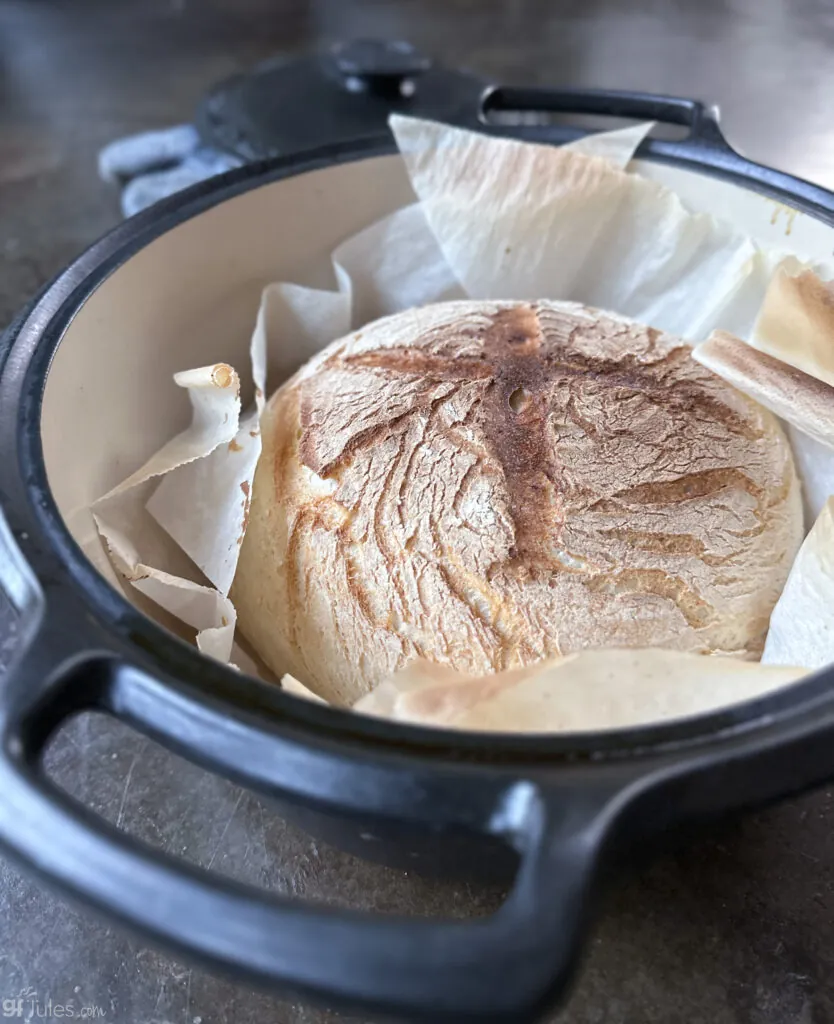
Gluten free sourdough made in an Emile Henry bread baker …
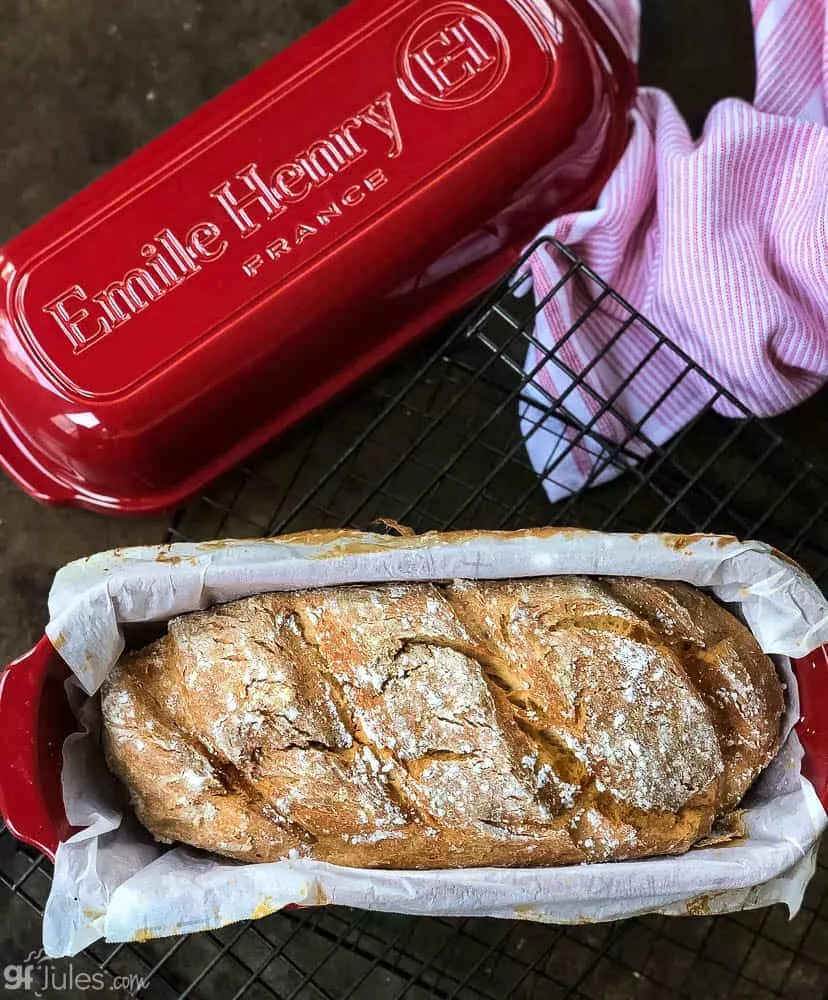
Gluten free sourdough baked in a Pullman Pan …
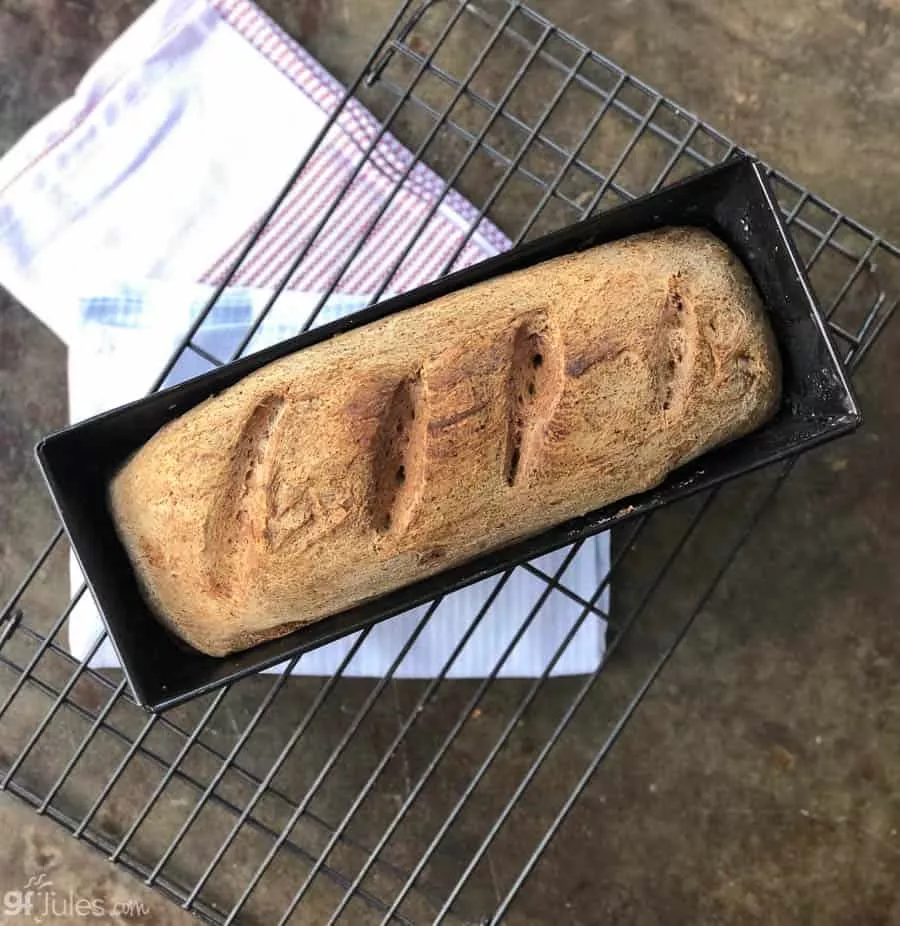
Gluten free sourdough baked as a boule without a pan …
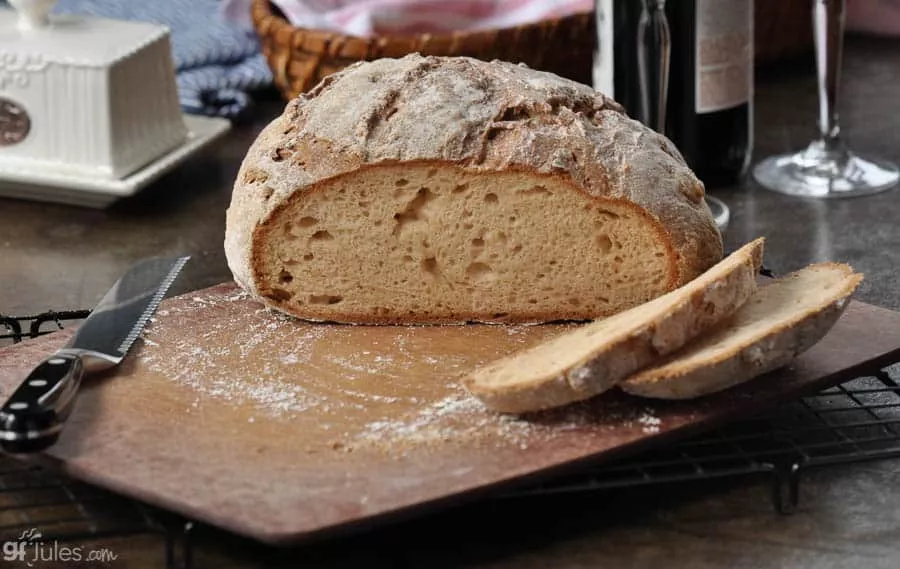
Gluten free sourdough baked on a baking steel and ultralight baking shell from Brod & Taylor. I’m loving this new-to-me method, by the way.
It’s similar to baking with a Dutch Oven, but the baking shell is so easy to handle and only weighs 1 pound 1 ounce! Comes in batard shape (shown here) or boule.
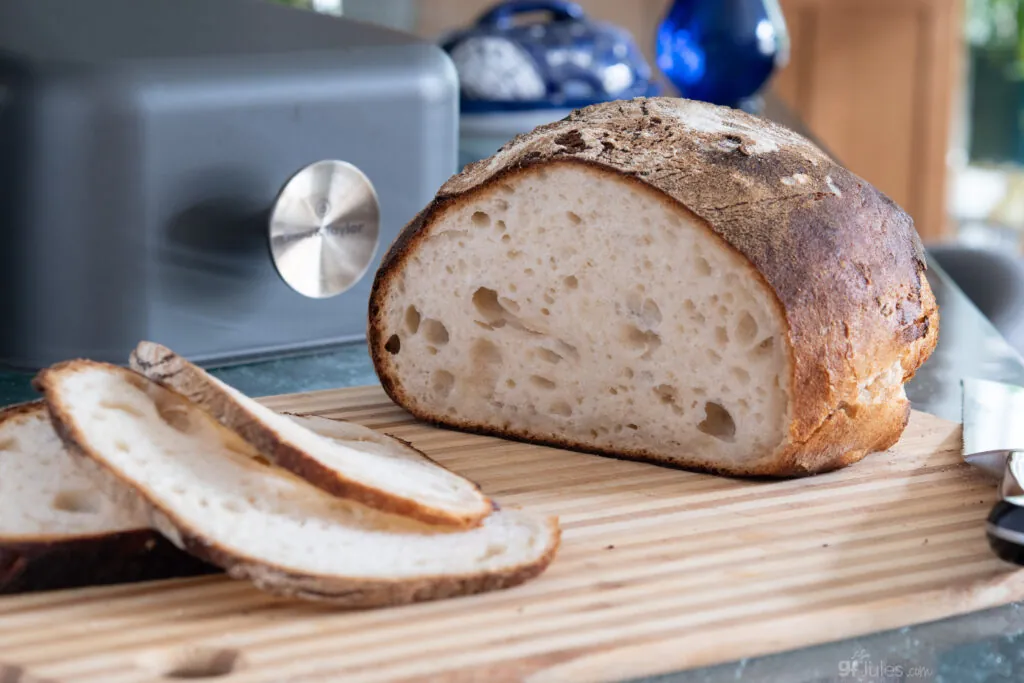
I’ve baked experiment after experiment, tweaking it here and there to account for lots of variables over the years, and I’m happy to share all my gluten free sourdough secrets and methods with you in this comprehensive post!
The creation of the first successful gluten free sourdough starter (click here for recipe) and gluten free sourdough bread recipe was a painstaking process, but at least we’ve enjoyed tons of gluten free sourdough along the way (leftover sourdough makes an insane overnight gluten free French Toast Casserole!).
I urge you to hang in there and read through my entire post, as I outline what has worked best and what has not worked best for me.
There are definitely some tricks of the trade, including how to get your gluten free sourdough to be sour!

Gluten Free Sourdough Basics
For those who love and miss sourdough, take heart! The art of making sourdough isn’t lost without the gluten. There’s still a lot of feeding, caring and waiting for the sourdough starter to mature and bloom into all its potential.
I’ve actually made so much starter that I’ve given much of it away to neighbors, but I just couldn’t throw any away when I’ve tended to it for so long! It’s like a little sourdough baby and you just can’t toss it out — I care about it! It’s “alive.”
Pro Tip: Use the search bar here at gfJules.com and search “sourdough” for lots of delicious gluten-free sourdough discard recipes so you don’t have to waste any of your precious discard either!
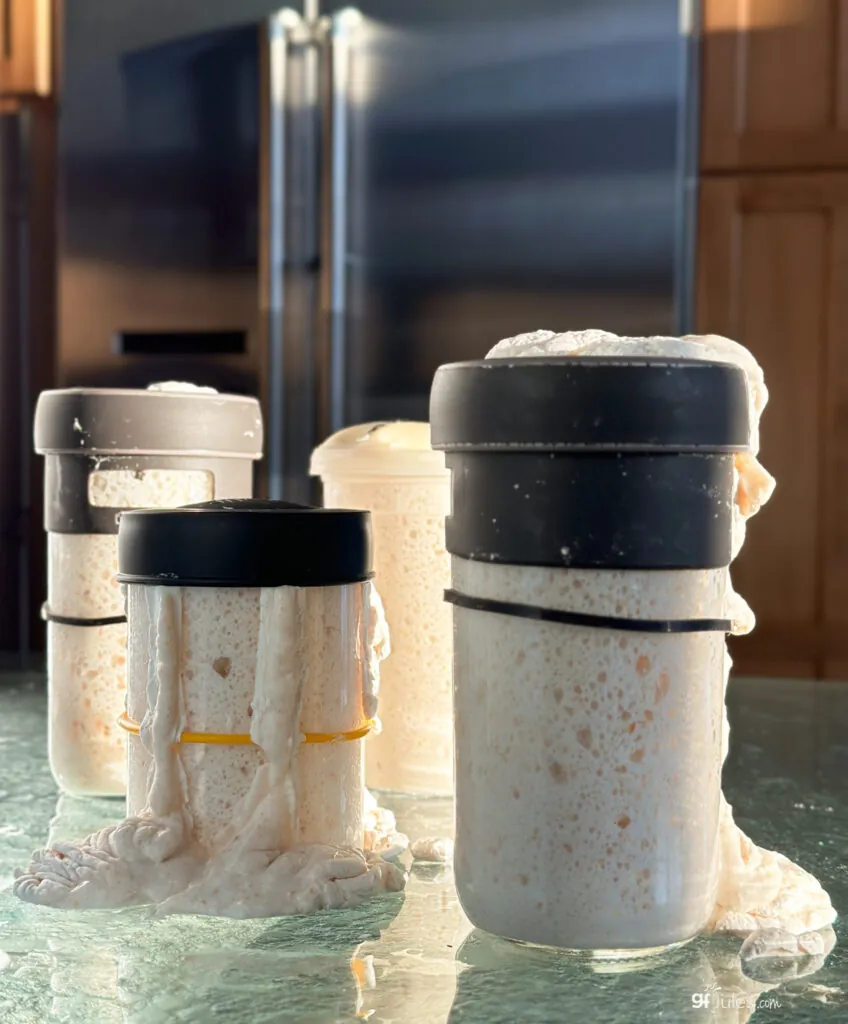
You’ll see when you make this gluten free sourdough starter; you’ll see. You won’t want to discard any of the “extra” either. It’s precious. Here’s how to make your very own gluten free sourdough starter!
Some things are the same about making gluten free sourdough bread as they are with making any other gluten free bread. There’s no kneading the bread and stretching the gluten because there’s no gluten! Just follow my instructions to the letter, use my gfJules Gluten Free All Purpose Flour or gfJules Multigrain Baking Flour and sit back to watch the magic happen.
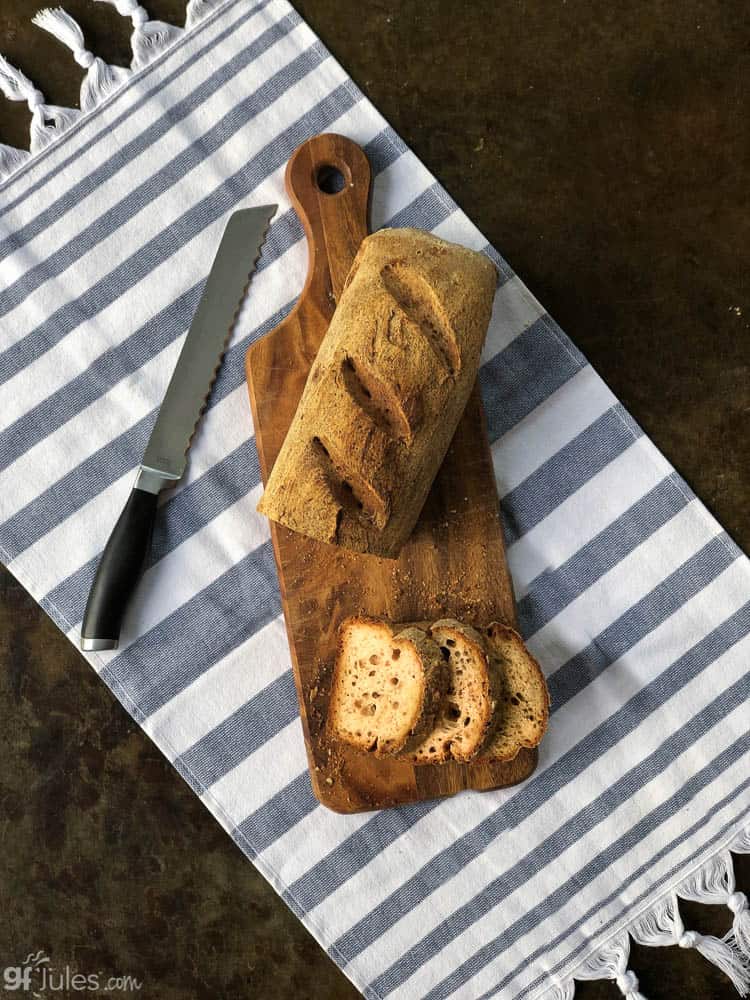
Choosing the Right Gluten Free Flours for Gluten Free Sourdough Bread
In anticipation of many questions to come, this recipe and process was developed using my gfJules Gluten Free All Purpose Flour because it works, I can rely on it every time, it’s easy, and it doesn’t taste funky or have any grit to it. If you try this recipe with another gluten free flour or blend, it really may not work, so please please please don’t even bother to try! But if you do, please don’t leave comments about how it didn’t work, because I’m telling you so before you waste your time.
Gluten free flours are tricky business. It took me two years to develop my original blend way back in 2003 (I’ve been gluten free since 1999!) and I’ve been tweaking and improving it ever since. Just because you think you can read ingredients and intuit how much of anything to use or to buy something off the shelf that sounds similar … you can’t. It won’t be the same, and the results won’t look like those pictured.
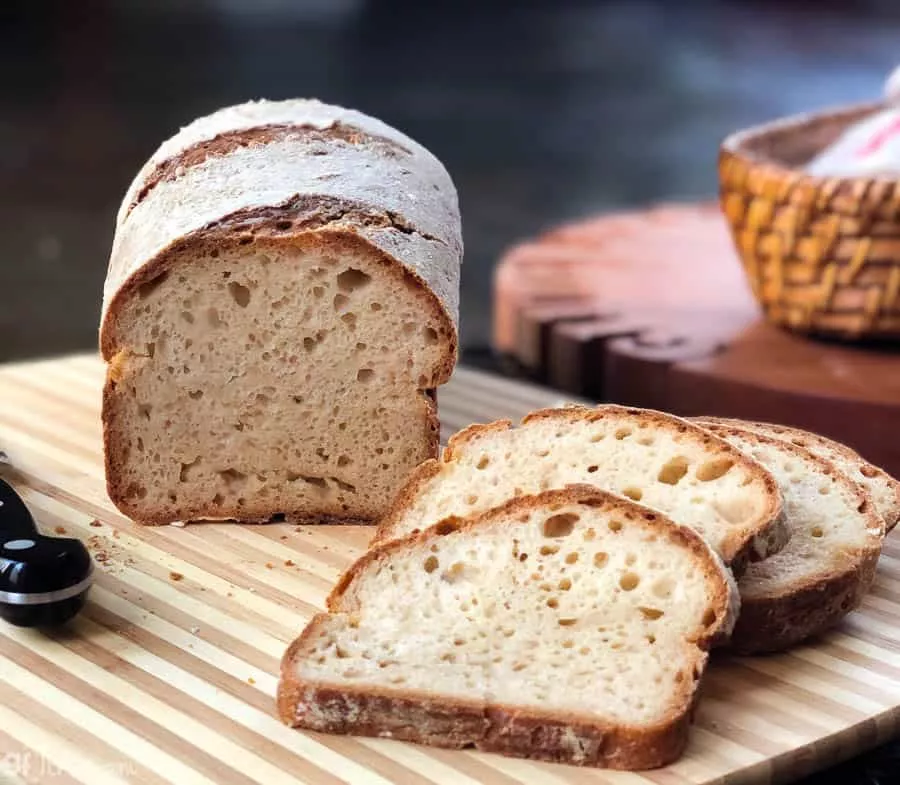
Not to belabor the issue, but tenths of a percentage point difference in proportions and a different brand or country of origin for any given ingredient are things that can make huge changes in outcomes. It amazes me all the time how tiny variances make big differences.
Which is why I developed my gfJules Flour to begin with. Selfishly, I didn’t want to have to make it in my kitchen every time I baked! And unselfishly, I wanted to prevent fellow gluten-free bakers (and newbies to gluten free baking) from having to mess around with mediocre flours only to achieve mediocre results.
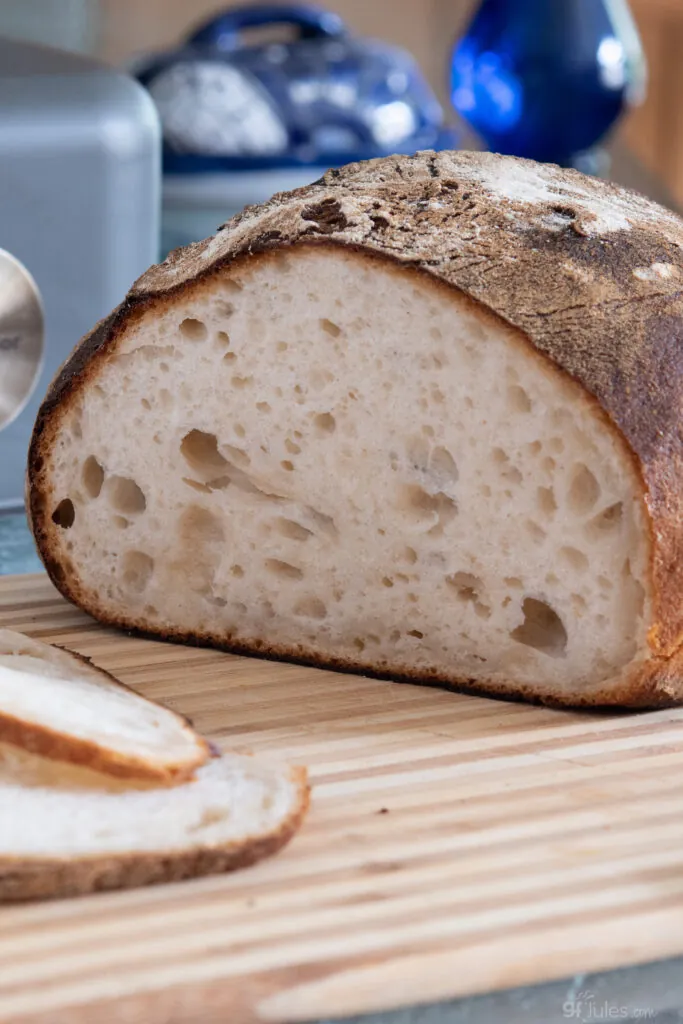
In the process of developing this gluten free sourdough recipe, I learned that my Gluten Free Multigrain Baking Flour is the PERFECT flour for sourdough starter. It goes crazy for it! So if you’re looking for the easiest way to get to gluten free sourdough nirvana, arm yourself with just two gluten free flour blends: gfJules Gluten Free All Purpose Flour and gfJules Gluten Free Multigrain Baking Flour. It’ll make your sourdough baking so much easier!
For more help with gluten free bread baking, in general, hop to my 18 Top Gluten Free Bread Baking Tips.
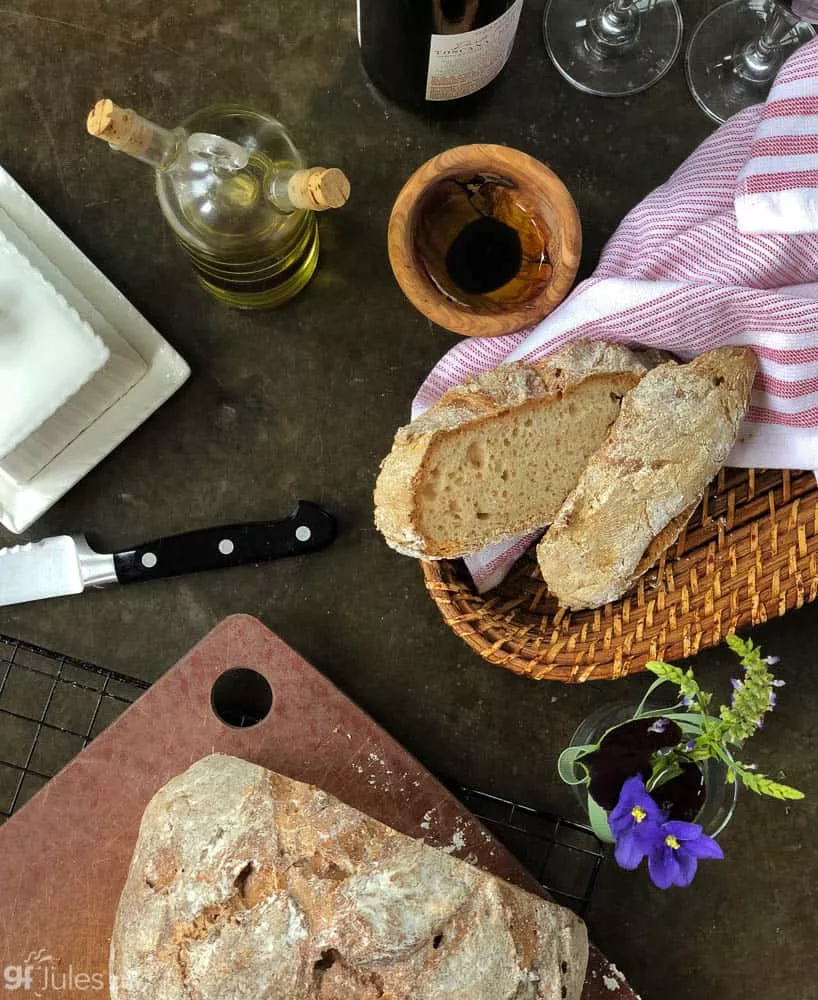
Baking Gluten Free Sourdough — Choosing the Right Pan
As you can see at the top of this post, there are many different options when it comes to baking your gluten free sourdough bread.
Follow along with one reader’s VIDEO of how she made her beautiful gluten free sourdough loaf using with this recipe and this artisan method following clicking here to watch!
Artisan Style Gluten Free Sourdough Bread Method
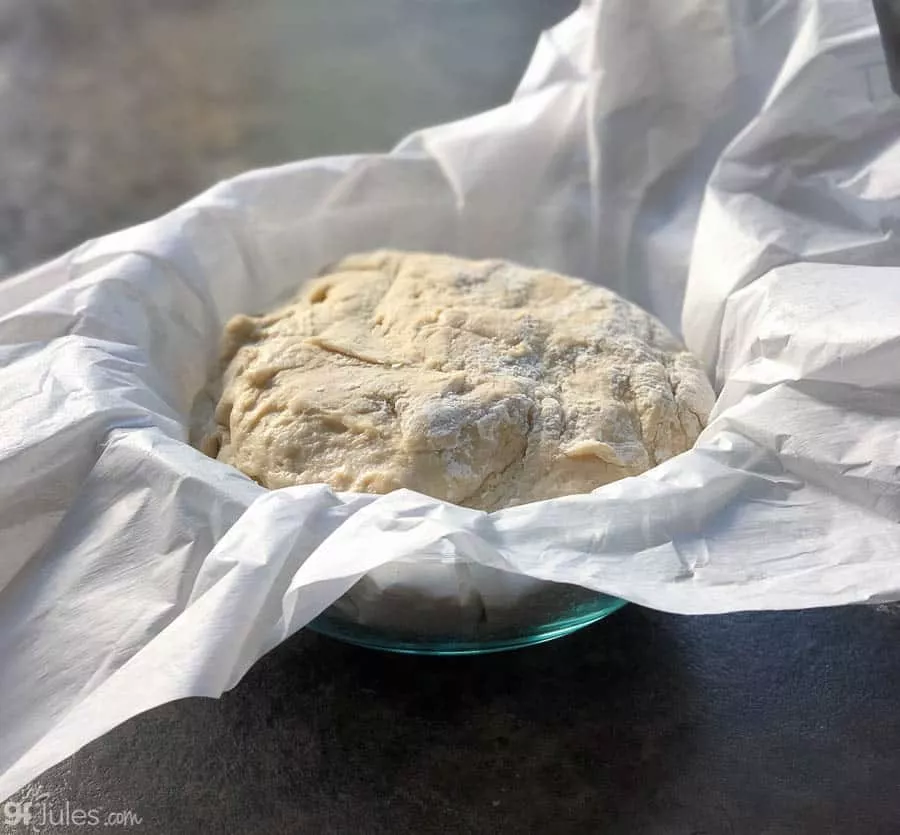
For an artisan-style boule, I prefer lining a banneton (proofing basket) or large glass bowl with oiled parchment sprinkled with more gfJules Flour to support the bread as it rises.
Once risen, I simply lift up on the parchment and lay it out onto a baking sheet for the bread to bake, or put it into a Dutch Oven, or slide onto a baking steel and cover with a baking shell.
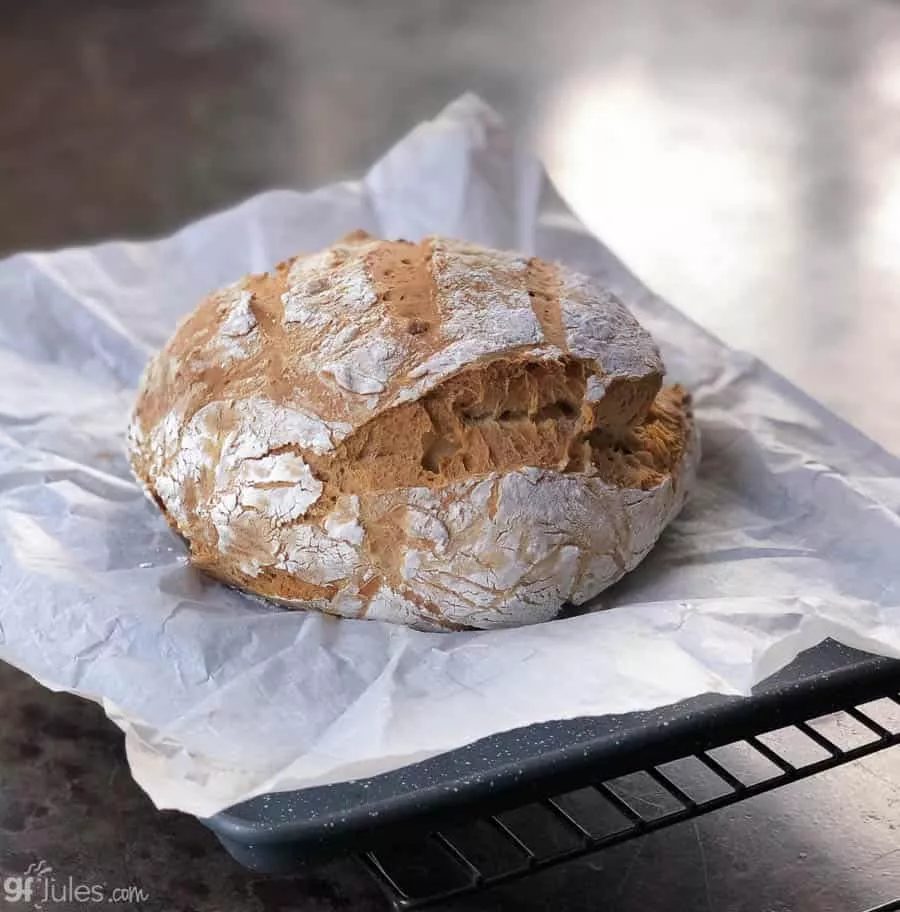
The bread will take more of a free-form shape, but it’s really beautiful and impressive!
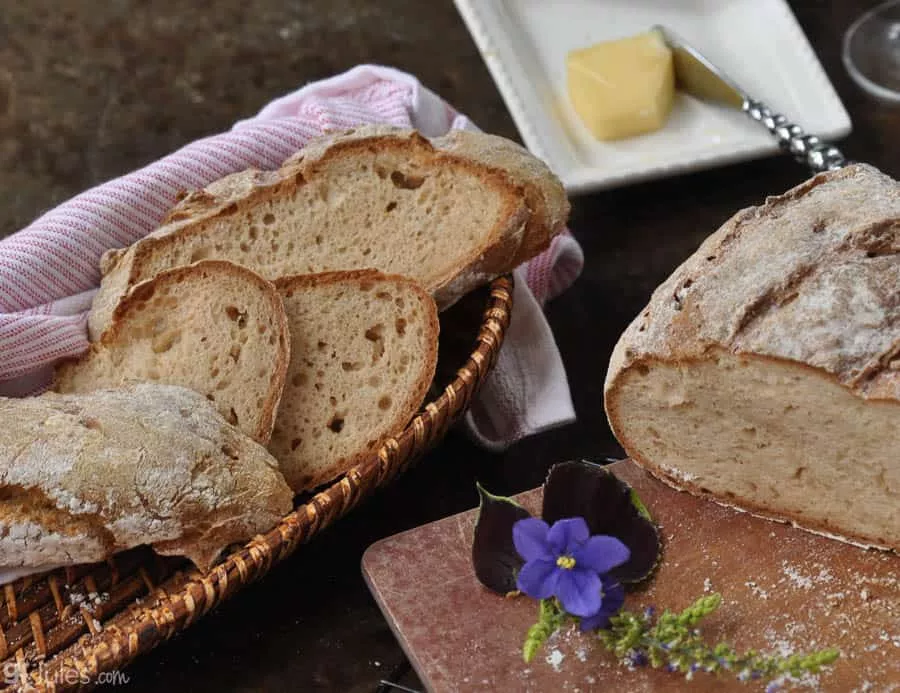
Using either the artisan or bread pan method, you may choose to dust the top of the loaf with gfJules Flour before baking for a more rustic look, or simply brush olive oil onto the top, or both.
Loaf Pan Gluten Free Sourdough Method
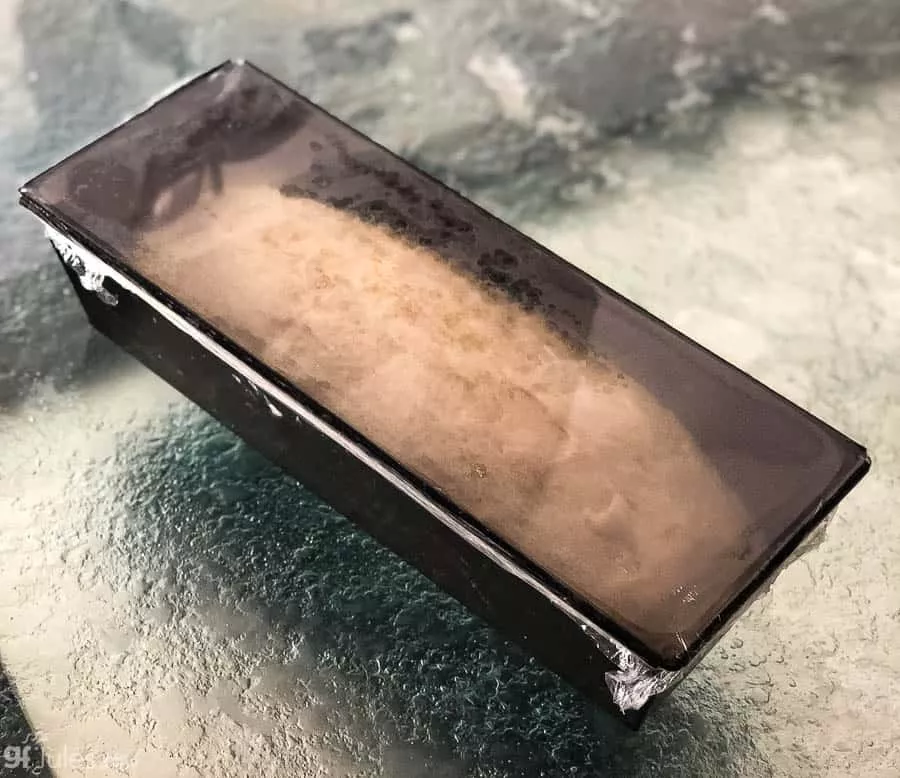
Place the dough into an oiled or parchment-lined pan and brush with oil. Allow the dough to rise covered with oiled plastic wrap to help keep the loaf warm and moist. I like putting the loaf into a preheated 200F oven, then turning the oven off, but turning the light on. I do this with the bread rising in either the bowl or the oiled and floured bread pan.
You can allow the bread to rise here for a minimum of 1 1/2 hours. I find around 2 hours is about right.
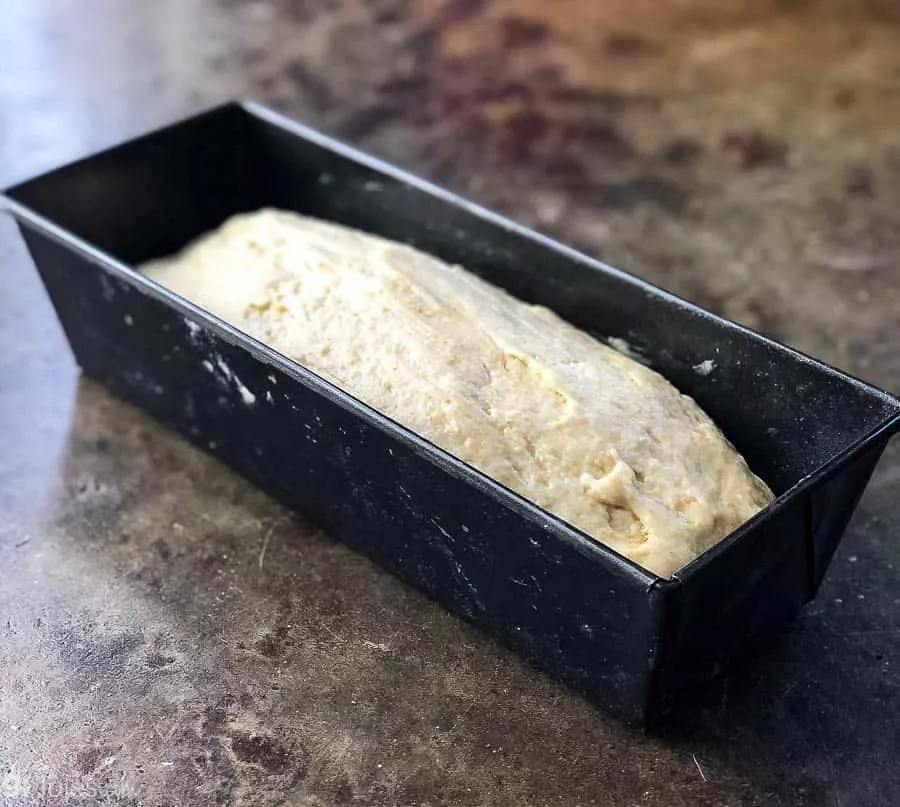
NOTE: The bread won’t have risen a lot, as most of the rising happens when it’s baking.
Feel free to oil and flour the bottom and sides of the pan or use lightly oiled and floured parchment for easier removal from the pan.
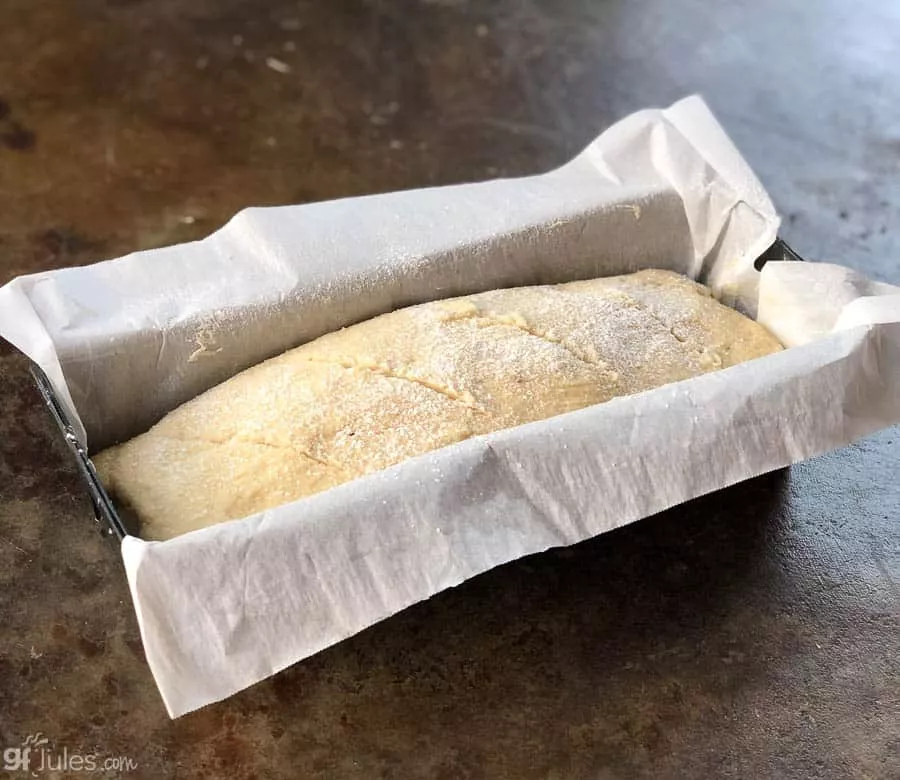
After rising, cut slits in the top of the loaf to direct the rise. Since the oil and/or the flour were applied before the slits were cut, the inside of the slits will appear different from the crust and it gives the sourdough the hand-made look it deserves.
Regarding bread pans, I experimented with all kinds and sizes. For loaves, I really like a Pullman Pan like I used in most of these photos, but a baker with a lid creates a Dutch oven effect which is great for the crust. The bread dough is a bit too voluminous for a traditional 9 x 5 (or smaller) bread pan; in those, this wet dough would rise high and then tended to collapse a bit, leaving some un-cooked looking areas in the center.
The Pullman Pan (mine is 12 x 4 1/2) seemed to be the perfect size to allow the bread to rise with support up the taller sides.
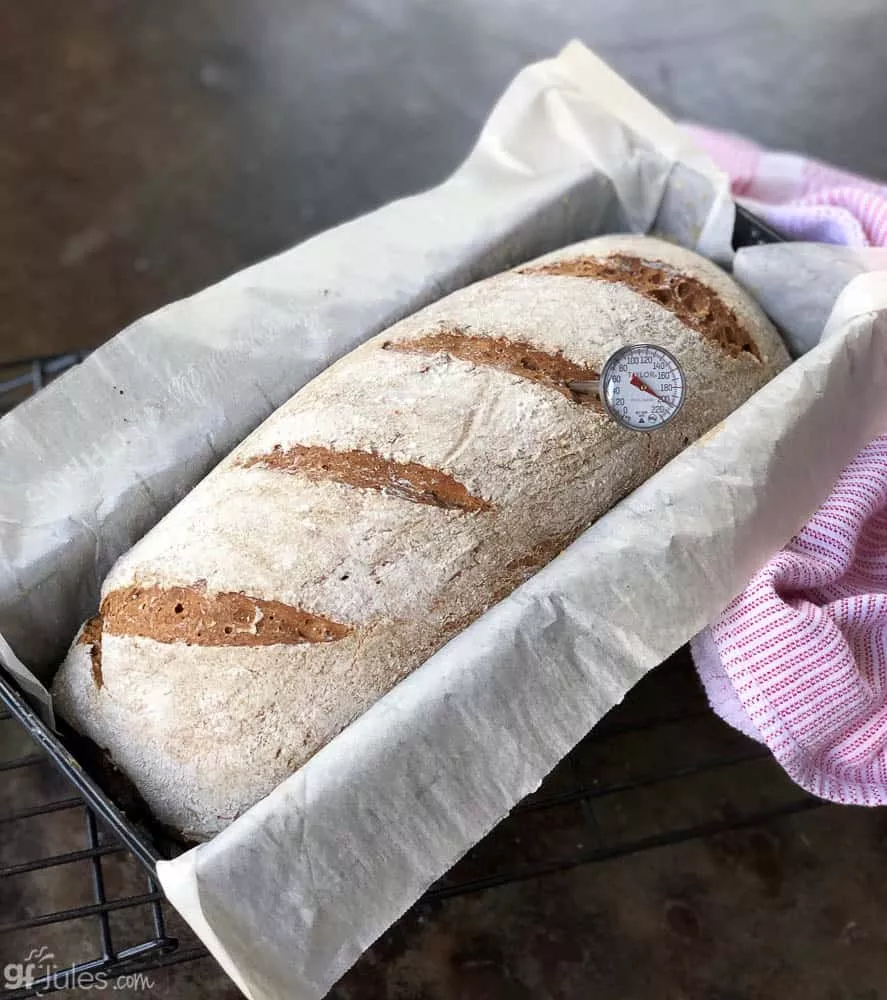
The time it takes to bake this bread will differ based upon the pan used and of course, on individual oven variations. I highly recommend buying an internal thermometer to take the bread’s temperature before removing it from the oven.
The internal temperature should be at least 205F before removing it from the oven to cool.
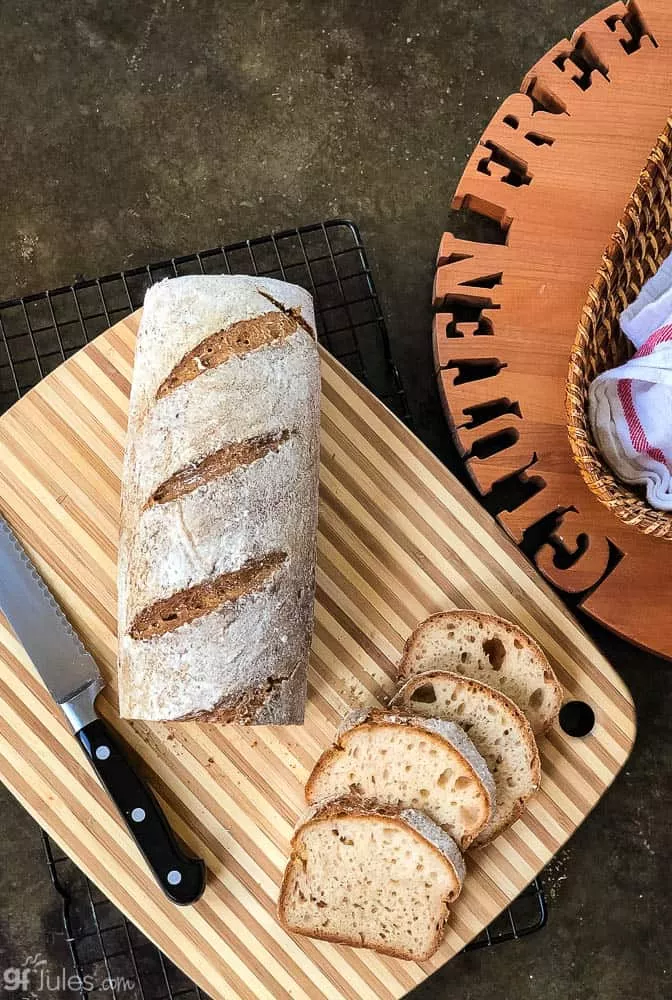
How to Make Gluten Free Sourdough Taste Sour
There are three main distinguishing features of sourdough: taste; smell; and texture. You might expect that the most difficult feature to achieve in gluten free sourdough would be texture, but as you can see from the photos, the artisan texture, open cell structure and crunchy crust are present in each of my loaves made with my gfJules Flour (plus psyllium husk) or my gfJules Bread Mix.
The smell is something that is quite noticeable from the starter. It should be tangy and rather sour smelling to know it’s really active. If your starter isn’t smelling very sour, it needs to age longer and/or be fed more.
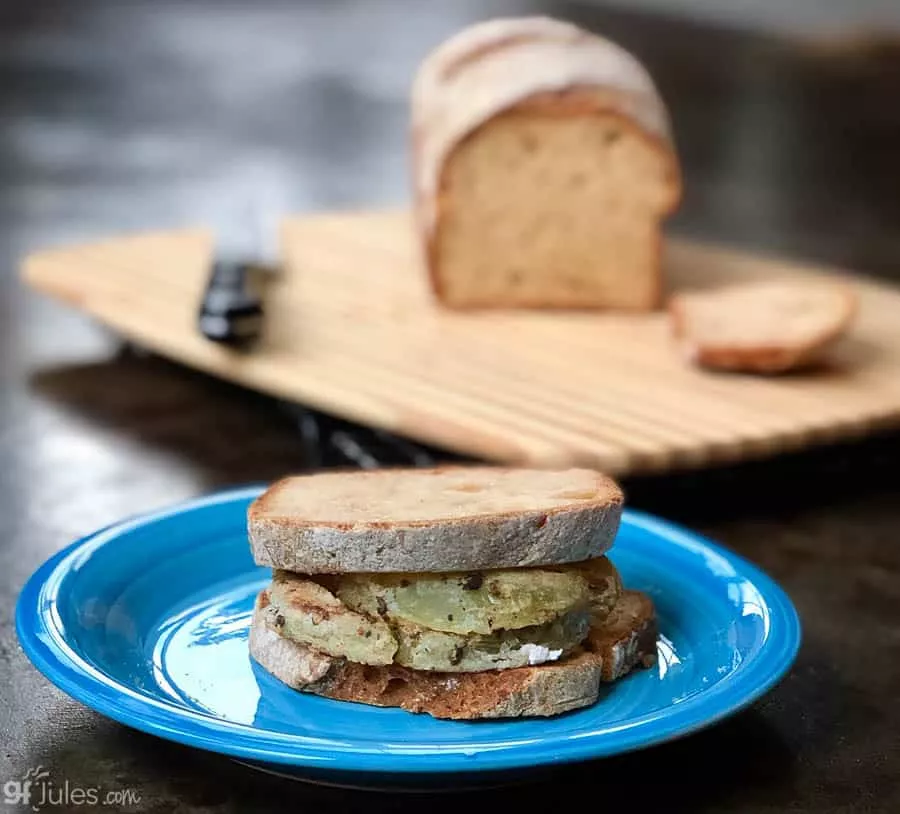
But the sour taste was the thing that seemed to be most elusive for me in my early bread experiments.
My first breads came out tasting yeasty and mild, just perfect for sandwiches or dipping in olive oil and balsamic (which we’ve been doing nearly every night for weeks now!).
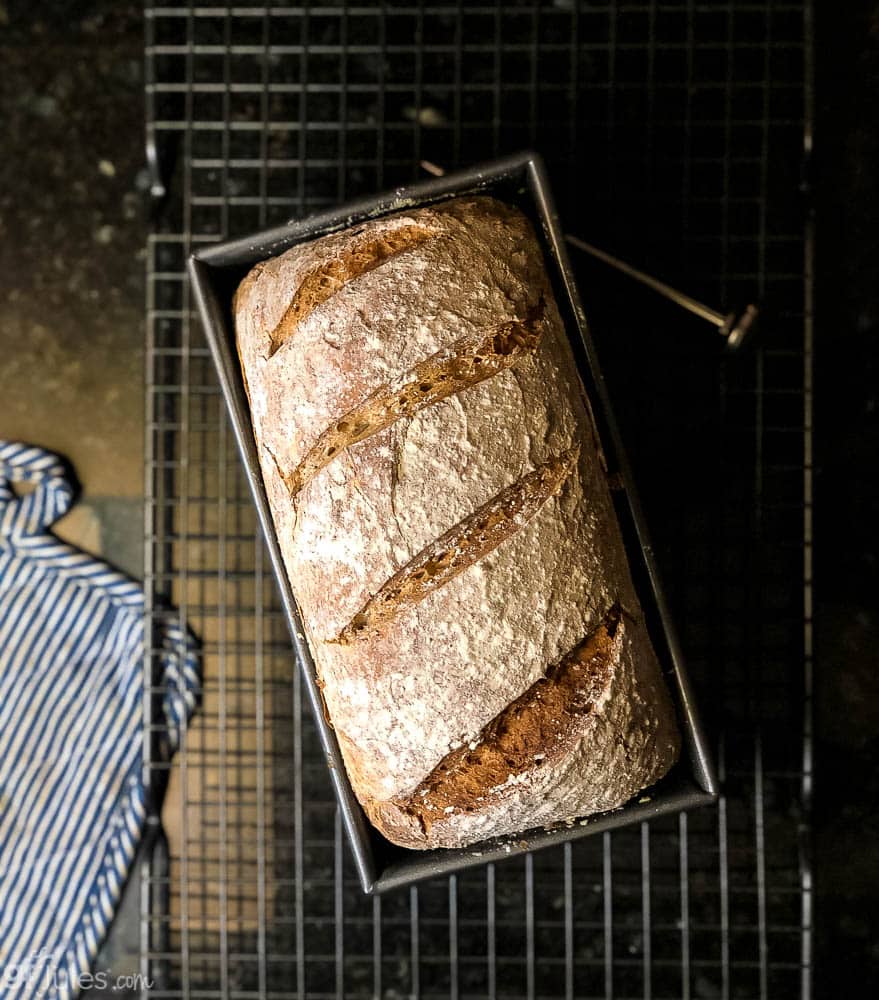
No, the sour taste didn’t come easily. I did achieve it somewhat when I allowed the bread to rise overnight, so if you are searching for that sour, I recommend budgeting time for an overnight rise. But I wanted MORE SOUR. Lucky for you, I cracked the code on that too.
How Do I Make Gluten-Free Sourdough Taste More Sour?
- Overnight Rise. I allowed my bread to rise as I described above, then placed it in the refrigerator overnight (still covered), then removed it the next day to sit on the counter to come to room temperature before baking. THEN the sour started to show through! (note: if you’re baking egg-free, leaving the dough covered in the oven turned off overnight is a good way to get that sour taste.)
- But even more revolutionary, I’ve recently changed my recipe to remove any chemical leaveners (baking powder, baking soda) which altered the pH and allowed the sour flavor to shine through. Those ingredients counteract the sour tang, so adding them negates the sour. This tweak has really made the difference in my gluten free loaves tasting more sour.
- Another site has recommended NOT feeding your sourdough starter again before baking with it in order to increase the sour flavor of the bread. This will also decrease the rise and will necessitate a longer proofing time, however. (Go here for the recipe to make your own gluten free sourdough starter)
- Add more apple cider vinegar. You can always add another tablespoon or two, and reduce the liquid in your recipe to compensate.
If you do any experimenting of your own and find other ways to make this bread taste sour-er, please share in the comments below!
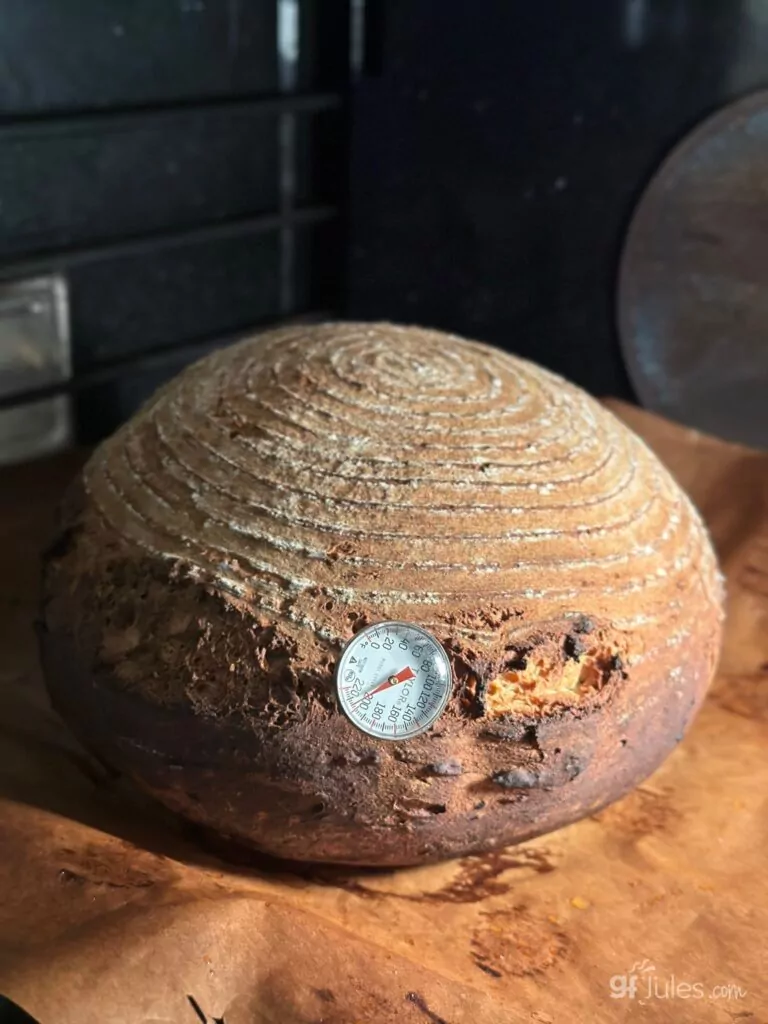
Storing Your Homemade Gluten Free Sourdough Bread
I always recommend storing your baked goods at room temperature in a sealed container, and this gluten free sourdough bread is no exception. The simple truth is that if you put baked goods into the refrigerator, they will dry out. You can put them into the freezer when they are fully cooled, but they will need to be warmed or toasted before enjoying again.
This gluten free sourdough bread is still soft and delicious after a few days in a zip top bag with the air squeezed out of it and stored at room temperature. Depending on the size of your loaf, you may need to cut it in half to get it to fit into a gallon sized bag, but other than that, it’s easy to just seal it up and grab a slice whenever you like! You can also store the bread European-style in a cloth or bread blanket.
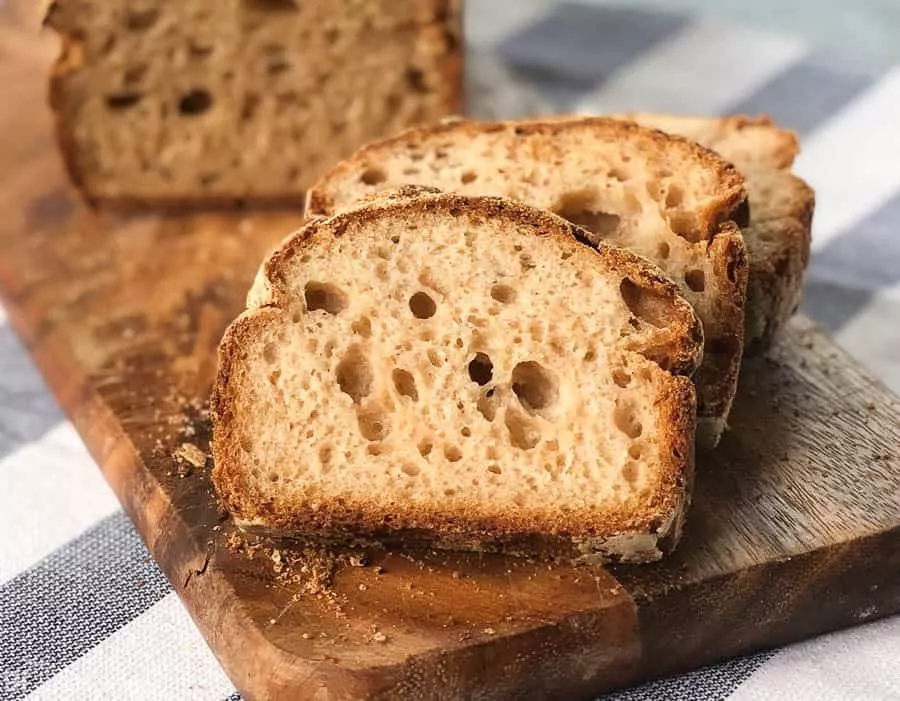
If you’d like to bake a regular gluten free artisan loaf without the sourdough starter, check out my Gluten Free Artisan Bread Recipe. And of course, my award-winning gfJules Gluten Free Bread Mix works well for any kind of sandwich bread, oven or bread machine, hamburger/hot dog bun or baguette recipe! Click on the “description” tab to find links to all these gluten free bread recipes or use the search bar above.
Also note that if you don’t have an aversion to using actual yeast, the best way to get a great rise AND the sourdough taste is to use a little yeast in your bread along with the sourdough starter. In France, in fact, it is permitted to add up to .2% active yeast to sourdoughs and still call the bread a naturally leavened sourdough. You’ll see I’ve recently added an option to add 1 teaspoon active dry or instant yeast to the dough if you’d like to try that method.
So let’s get down to baking great gluten free sourdough, shall we?
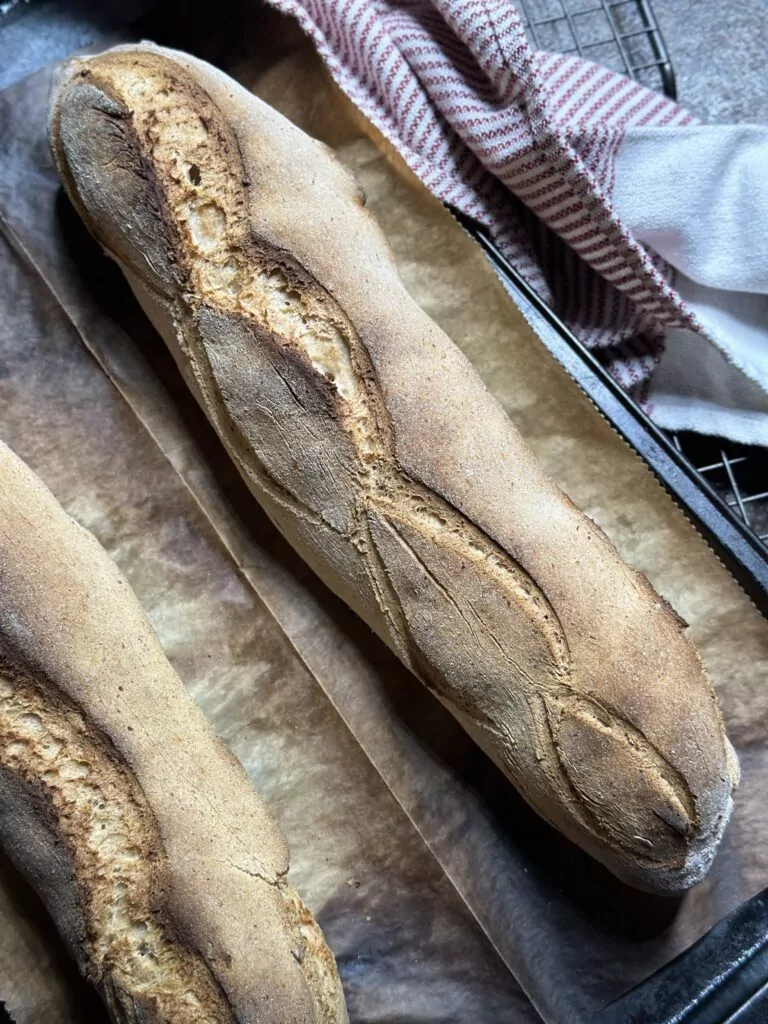
To make a homemade gluten free sourdough starter, hop to this recipe!
Note that this recipe is constantly evolving, the more loaves I bake, the more research I do, and the more feedback I get from you, my readers! What was great gets even better, so keep checking back in for updates to the recipe!

Gluten Free Sourdough Bread Recipe
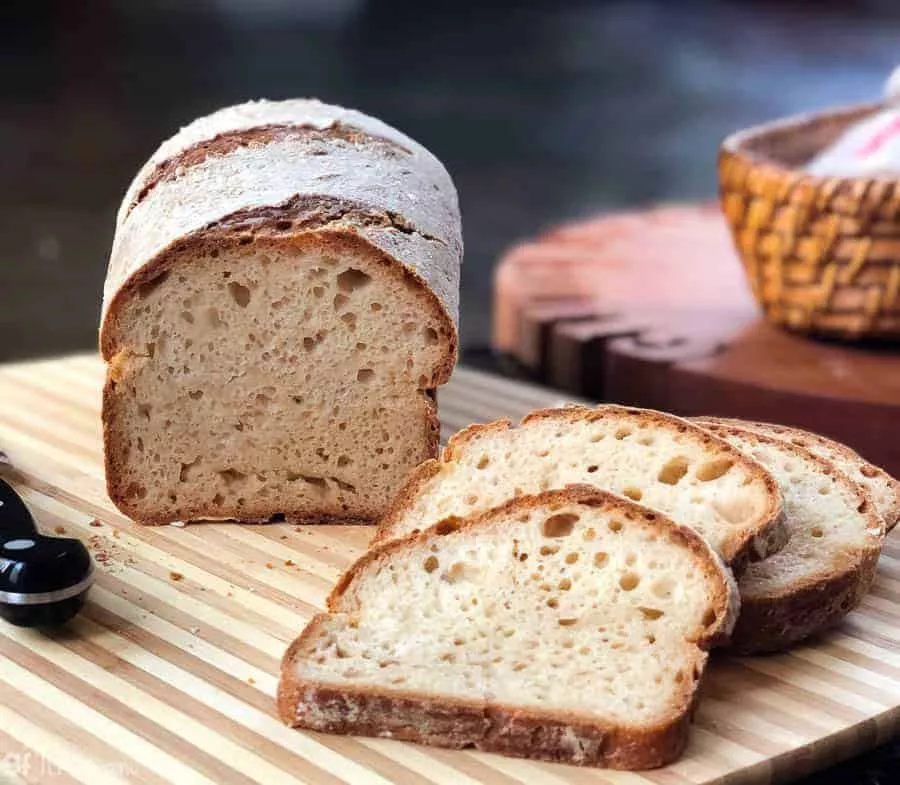
Gluten Free Sourdough Bread Recipe
Equipment
Ingredients
Sourdough Loaf or Artisan Bread Dry Ingredients
OR from scratch:
- 3 (420) cups (grams) gfJules® Gluten Free All Purpose Flour (for this recipe measure each cup to 140 grams/cup)
- 1/2 (70) cup (grams) gfJules Corn-Free Multigrain Flour (OR mixture of buckwheat flour OR cassava flour OR almond meal OR millet flour OR sorghum flour OR coconut milk powder)**
- 2 teaspoons kosher sea salt
- 1 teaspoon rapid rise yeast or active dry yeast like Red Star (this is OPTIONAL, but recommended if using young starter or less rise time)
PLUS These Other Ingredients
- 2 Tablespoons apple cider vinegar
- 1/4 (56) cup (grams) sugar
- 1 (11) Tablespoon (grams) psyllium husk powder (DO NOT ADD if using gfJules Bread Mix) optional with scratch recipe, but recommended (without psyllium, liquid may need to be reduced by 2-4 Tbs. if dough is too loose)
- 3/4 (185) cup (grams) active gluten free sourdough starter (feed 4-6 hours before)
- 1½ cup bubbly liquid like club soda, sparkling water, ginger ale OR naturally gluten free beer
Instructions
- Bring all ingredients to room temperature.
- Preheat oven to 200°F if rising there.
- Stir the following ingredients together in a large mixing bowl: apple cider vinegar, sugar, psyllium husk powder, and gluten-free sourdough starter. Mix until smooth and thickened, approximately 2 minutes. (If using gfJules Bread Mix, stir just until mixed, since you aren't adding psyllium.)
- In a separate bowl, whisk together remaining dry ingredients, then slowly add into the large mixing mixing bowl together with bubbly liquid. Use the paddle attachment on a stand mixer or a dough mixer hand tool. Mix until dough comes together. (If adding active yeast, proof before adding.) Mix for two minutes with mixer, longer if by hand.
- Transfer dough to a clean counter or pastry mat dusted well with gfJules Flour. Turn dough several times in flour to smooth the dough and shape into a ball or a log for a loaf pan.
If Baking in Loaf Pan:
- Transfer dough to an oiled or parchment-lined Pullman Pan or 9x5 loaf pan, lightly dusted with gfJules Flour, or to floured parchment-lined pan or bowl for rising. Spritz with water, brush with olive oil, and dust the top of the dough with more gfJules Flour for best results.
- Cover with oiled plastic wrap and set inside oven warmed to 200℉. Turn oven off and turn light on.
- Allow the dough to rise for at least 1½ hours, or up to 3 hours before baking. Alternatively, after 3 hours, remove to refrigerator for further overnight rise. If refrigerating overnight, bring the dough to room temperature before baking the next day.
- Preheat oven to 350° F or 325° F convection.
- Remove plastic wrap and slice across the top of the dough as pictured to direct the rise.

- If you prefer a very crunchy crust, fill a spray bottle with water and spritz the dough again before baking, and again every 15-20 minutes while baking.
- Bake loaf in the pan for 75 minutes and test with a bread thermometer. The internal temperature should reach at least 205° F before removing to cool. If the bread is browning too much, cover with foil in order to keep baking.
- Once bread is fully cooked, remove to cool on a wire rack for 15 minutes before removing from the pan. Allow to fully cool before slicing.

If Baking Artisan Bread:
- Transfer to a proofing basket or oiled parchment-lined glass bowl.
- Cover loosely with a warm, damp tea towel or oiled cling wrap and place in a warm spot to rise for 1 - 3 hours before baking. Alternatively, after rising, remove to refrigerator for further overnight rise. If refrigerating overnight, bring the dough to room temperature before baking the next day.
- Invert gently onto a parchment lined baking sheet and remove basket or bowl. Cut a slice across the top at an angle with a lame or sharp knife before baking.

If Baking in Dutch Oven or Using Baking Shell:
- Place Dutch Oven inside oven and preheat oven to 500°F. If using a baking steel and shell method, place the baking steel on the oven rack to preheat (no need to preheat the baking shell).Once the Dutch Oven is preheated, remove lid and place parchment with dough boule inside, spritz with water, then replace the lid and put the Dutch Oven back inside the oven. If using baking shell, transfer loaf onto parchment and slide onto hot steel in the oven (using a dough or pizza peel helps here) then cover with baking steel.Bake for 20 minutes covered, then remove the lid and reduce the oven temperature to 450°F and bake for 25 more minutes. *To prevent the bottom of the loaf from burning, place an oven safe pan at least the diameter of your Dutch Oven or steel on the rack just below and fill with ice cubes. This will provide both steam and a buffer between the heating element and the bottom of the pan.*

If Baking On Baking Sheet:
- If baking without pan, place bread on parchment lined pan in 500°F preheated oven, then immediately reduce the temperature to 450°F and bake for 35 minutes, test internal temp and continue to bake if needed -- bake until bread is browned and internal temperature reaches at least 205°F. *To prevent the bottom of the loaf from burning, place an oven safe pan at least the diameter of your bread on the rack just below your baking pan and fill with ice cubes. This will provide both steam and a buffer between the heating element and the bottom of the pan.*

- Using either method, once the bread is baked, turn the oven off but leave the bread inside the oven with the oven door cracked for another 20 minutes before removing. Allow to fully cool before slicing to prevent any gumminess.
Video
Notes
- 56 grams sugar
- 2 Tbs. apple cider vinegar
- 3/4 cup active sourdough starter (fed ~6 hours earlier)
- 1 1/4 cup warm water
** Please keep in mind that nutrition information provided is per serving, which may vary. While we have taken care to provide you with the most accurate nutritional values possible, please note that this information may differ significantly depending on the exact ingredients and brands that you choose to use to make this recipe. Additionally, where options are given for ingredients, the resulting calculation may include all ingredient options instead of only one per line, skewing the totals significantly.
Recommended Products
Any links to Amazon may earn me a small amount from qualifying affiliate purchases; this amount goes to fund this blog and does not cost you anything additional.

Viva Naturals

Bragg Live Food Organic Apple Cider Vinegar 946ml/32fl oz

Regency Wraps RW450N, 9 Sq. ft, Natural

gfJules All Purpose Gluten Free Flour

Norpro NOR-3952 12" Bread PAN, Non-Stick, 12 inch

Empty Amber Glass Spray Bottles with Labels (2 Pack) - 16oz Refillable Container for Essential Oils, Cleaning Products, or Aromatherapy - Durable Black Trigger Sprayer w/Mist and Stream Settings

gfJules Gluten Free Sandwich Bread Mix
Can I Make GRAIN Free Sourdough?
I’ve been getting this question a lot lately. Grain-free blends are very different from gluten free flour blends, and they behave differently in yeast breads. BUT … I have developed a mostly GRAIN-FREE Sourdough variation that is quite lovely with my gfJules Nada Flour.
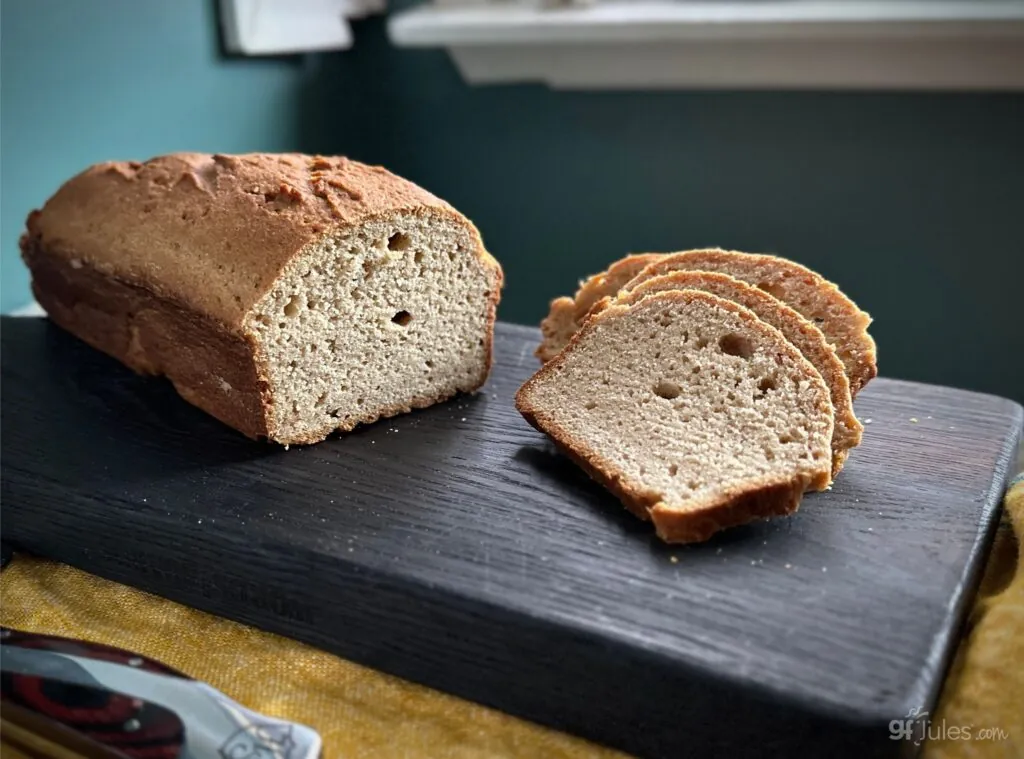
Of note: the starter I used was based on my gfJules Multigrain Flour, so it does contain grains, thus, this loaf is not entirely grain-free.
I have not yet had time to develop a grain-free starter. Alas, I am but one baker. Someday ….
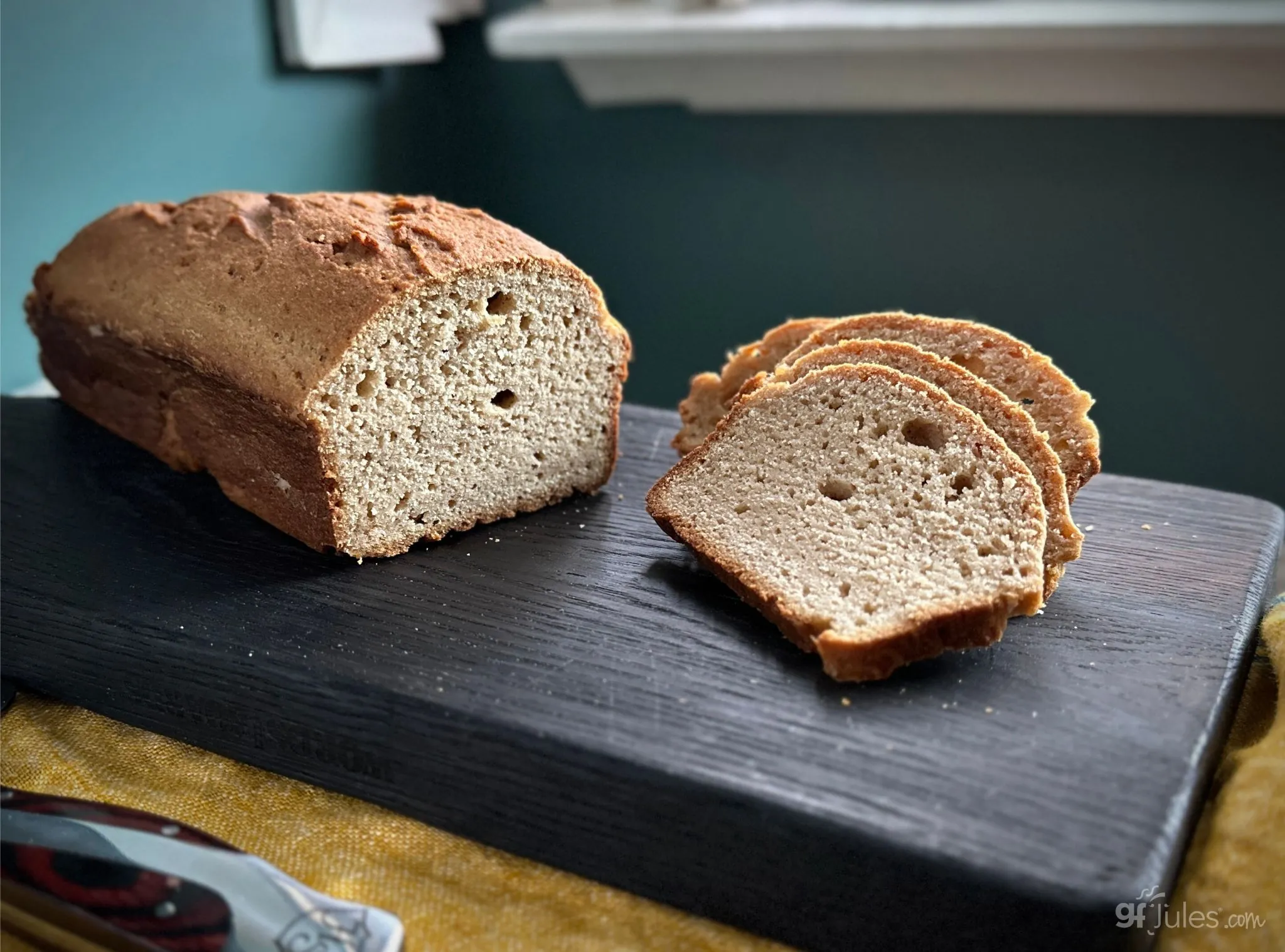
Mostly GRAIN Free Sourdough Bread Recipe
Ingredients
Sourdough Loaf or Artisan Bread Dry Ingredients
PLUS These Other Ingredients
- 2 large eggs OR 2 Tbs. flaxseed meal steeped 10 minutes in 6 Tbs. warm water
- 2 Tbs. apple cider vinegar
- 1/4 cup olive oil
- 1/4 cup 56 grams sugar
- 1 cup gluten free sourdough starter
- 1 cup club soda sparkling water, ginger ale, 7-Up, naturally gluten free beer, OR still water
Instructions
- Bring all ingredients to room temperature.
- Preheat oven to 200°F.
- Beat the following ingredients together in a large mixing bowl: eggs (or substitute), apple cider vinegar, oil, sugar, and gluten free sourdough starter. Mix until smooth.
- Slowly stir in dry ingredients with liquid, beating with paddle attachment on a stand mixer or using a wooden spoon until the batter is smooth and all dry ingredients are completely integrated. Mix for two minutes with mixer, longer with spoon method.
If Baking in Loaf Pan:
- Transfer dough to an oiled Pullman Pan or 9x5 loaf pan, lightly dusted with gfJules Nada Flour. Dust the top of the dough with more gfJules Nada Flour.
- Spritz with water and cover with oiled plastic wrap and set inside oven. Turn oven off and turn light on.
- Allow the dough to rise for at least 1 1/2 hours, or up to 3 hours before baking. Alternatively, after 3 hours, remove to refrigerator for further overnight rise. If refrigerating overnight, bring the dough to room temperature before baking the next day.
- Preheat oven to 425° F.
- Remove plastic wrap and slice across the top of the dough to direct the rise.
- If you prefer a very crunchy crust, fill a spray bottle with water and spritz the dough before baking, and again every 15-20 minutes while baking.
- Place uncovered loaf pan in oven, then reduce temp to 350° F. Bake loaf in the pan for 75 minutes before testing with a bread thermometer. The internal temperature should reach at least 205° F before removing to cool. If the bread is browning too much, cover with foil in order to keep baking. Bake for full 75 minutes, even if bread has reached internal temp earlier.
- Once bread is fully cooked, remove to cool on a wire rack for 15 minutes before removing from the pan. Allow to fully cool before slicing.
** Please keep in mind that nutrition information provided is per serving, which may vary. While we have taken care to provide you with the most accurate nutritional values possible, please note that this information may differ significantly depending on the exact ingredients and brands that you choose to use to make this recipe. Additionally, where options are given for ingredients, the resulting calculation may include all ingredient options instead of only one per line, skewing the totals significantly.
Recommended Products
Any links to Amazon may earn me a small amount from qualifying affiliate purchases; this amount goes to fund this blog and does not cost you anything additional.

Viva Naturals

Bragg Live Food Organic Apple Cider Vinegar 946ml/32fl oz

Regency Wraps RW450N, 9 Sq. ft, Natural

gfJules All Purpose Gluten Free Flour

Norpro NOR-3952 12" Bread PAN, Non-Stick, 12 inch

Empty Amber Glass Spray Bottles with Labels (2 Pack) - 16oz Refillable Container for Essential Oils, Cleaning Products, or Aromatherapy - Durable Black Trigger Sprayer w/Mist and Stream Settings

gfJules Gluten Free Sandwich Bread Mix
Many thanks to the indomitable Chef Patrick Auger for his help in developing this original recipe years ago. His passion for baking allergen-friendly foods has helped many a baker achieve amazing gluten free results like these!
I can’t wait to hear about your gluten free sourdough bread baking!
Pin for later!
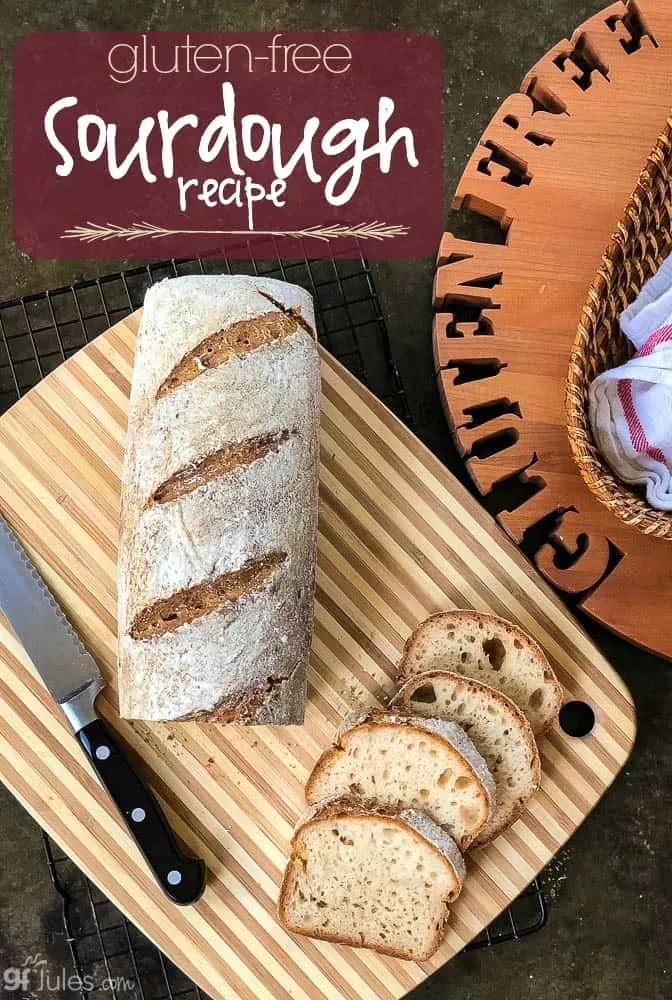
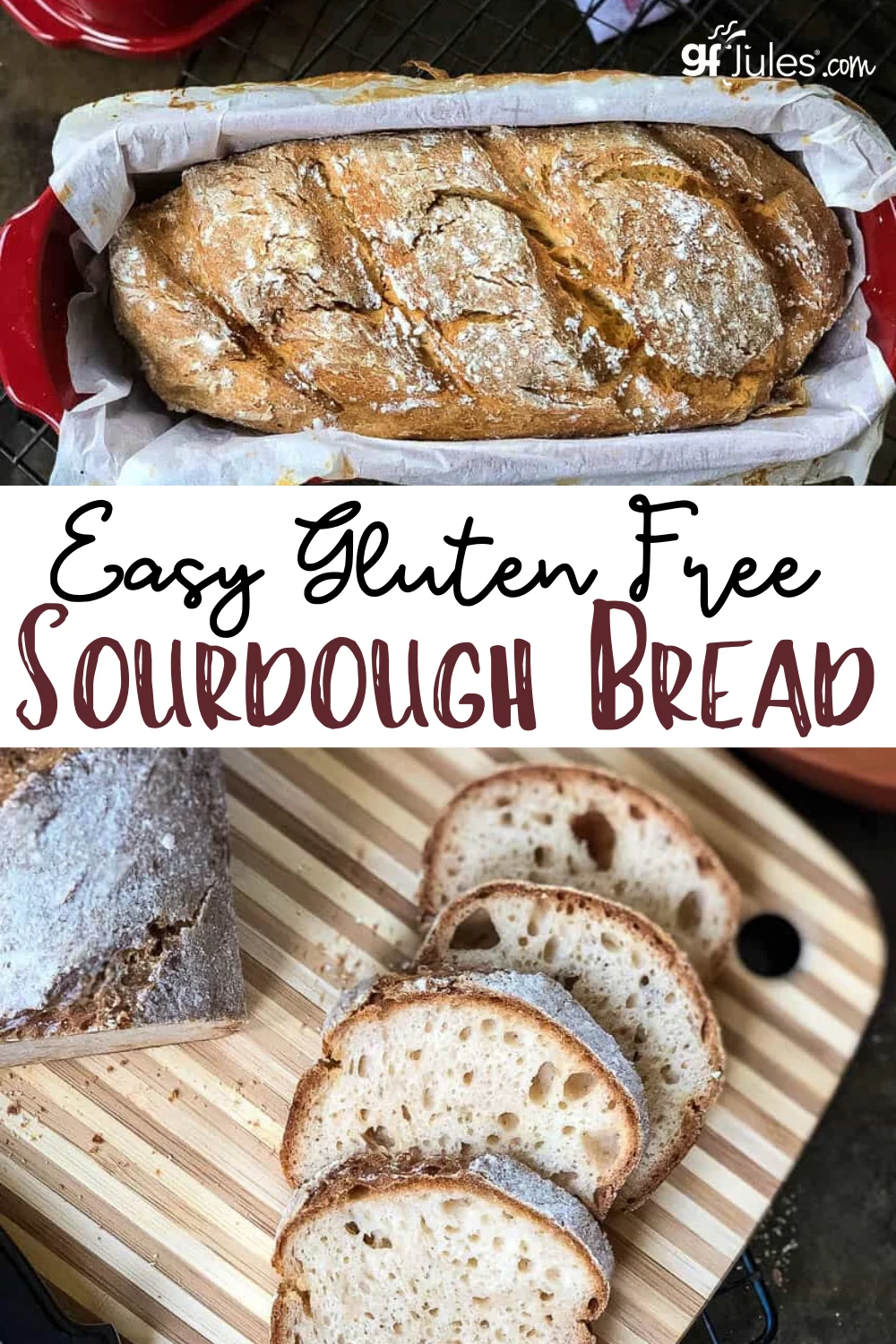
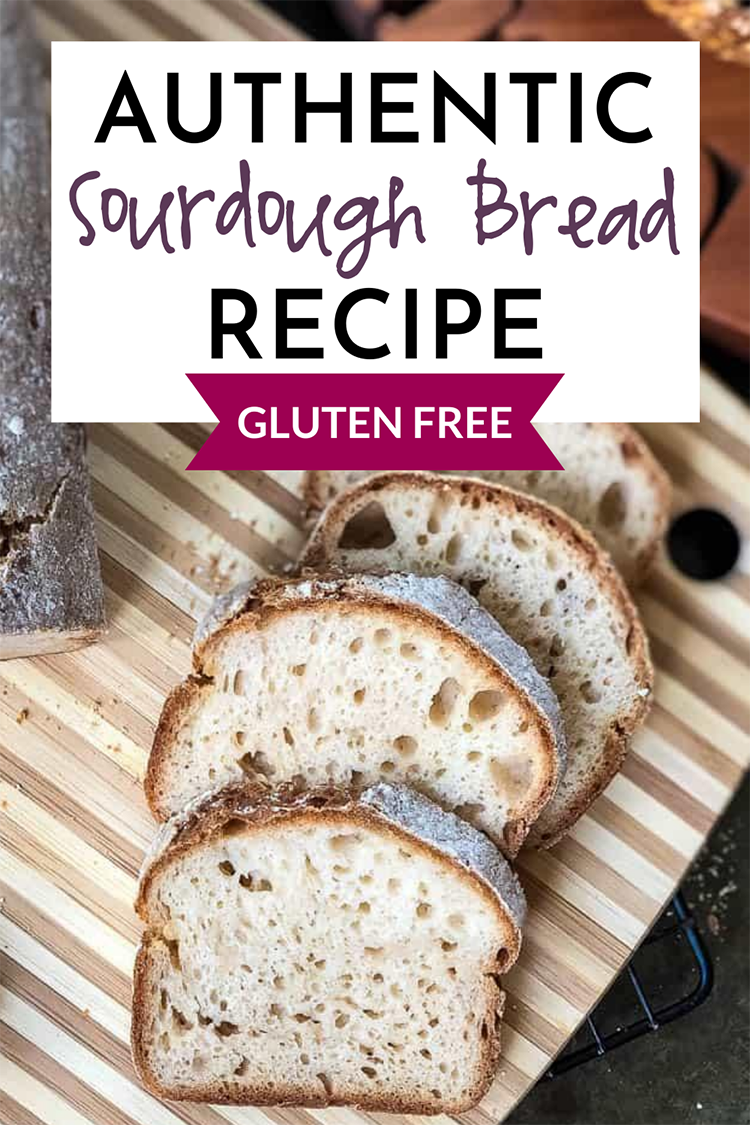
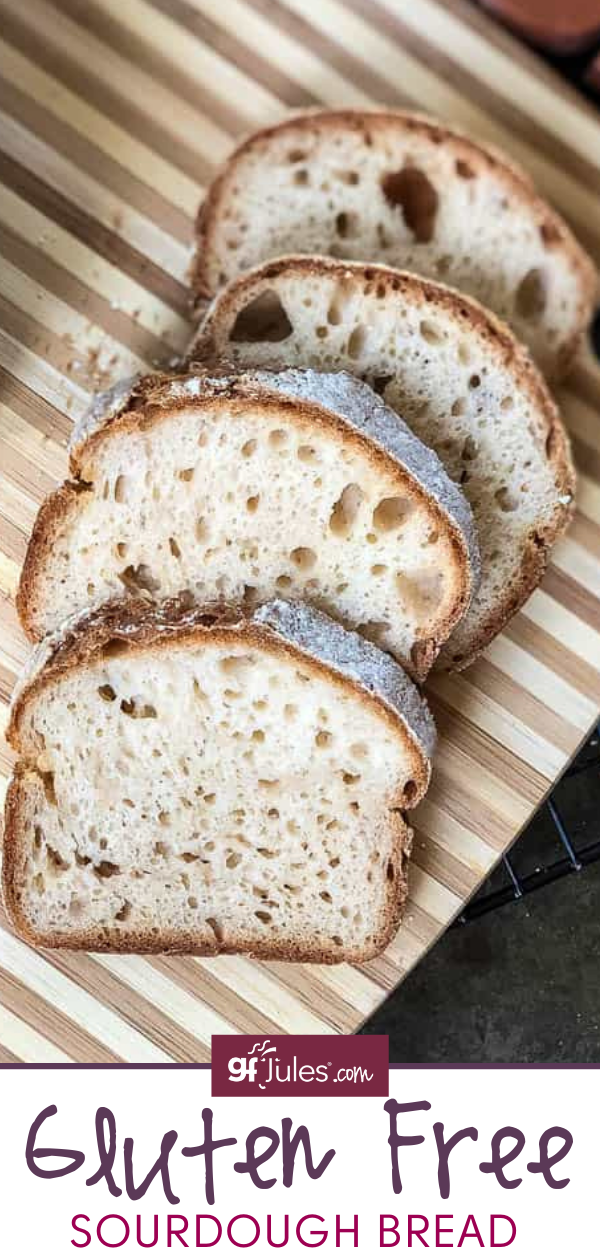





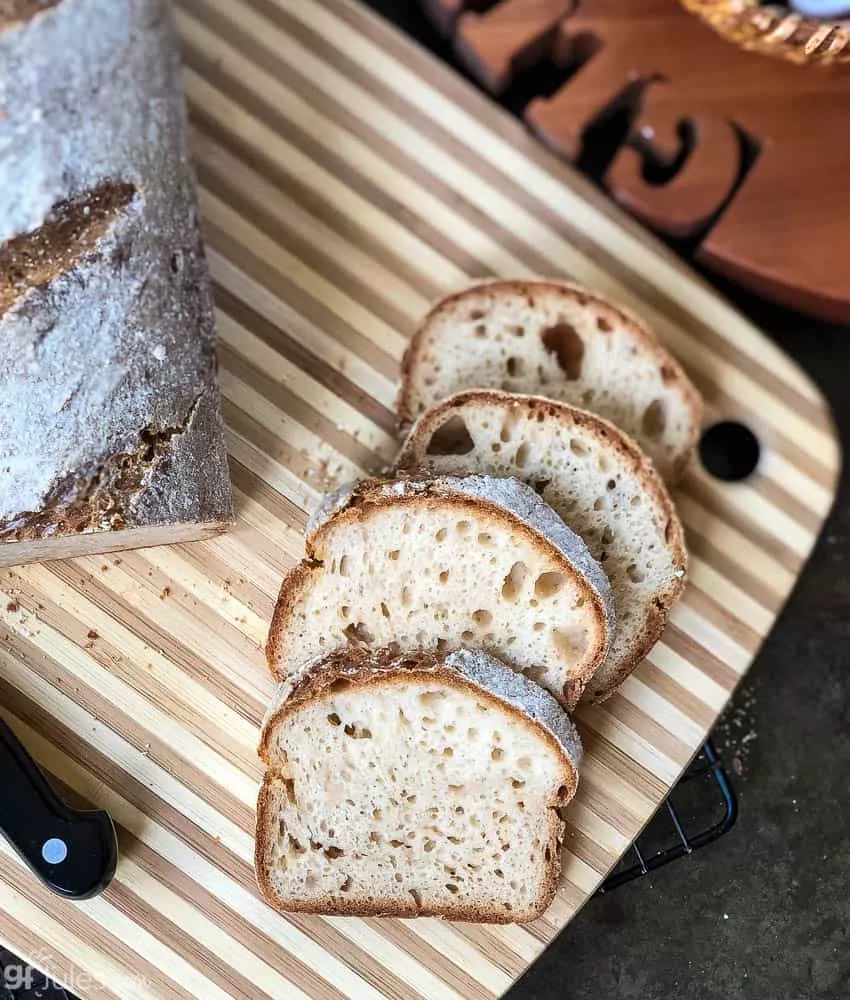
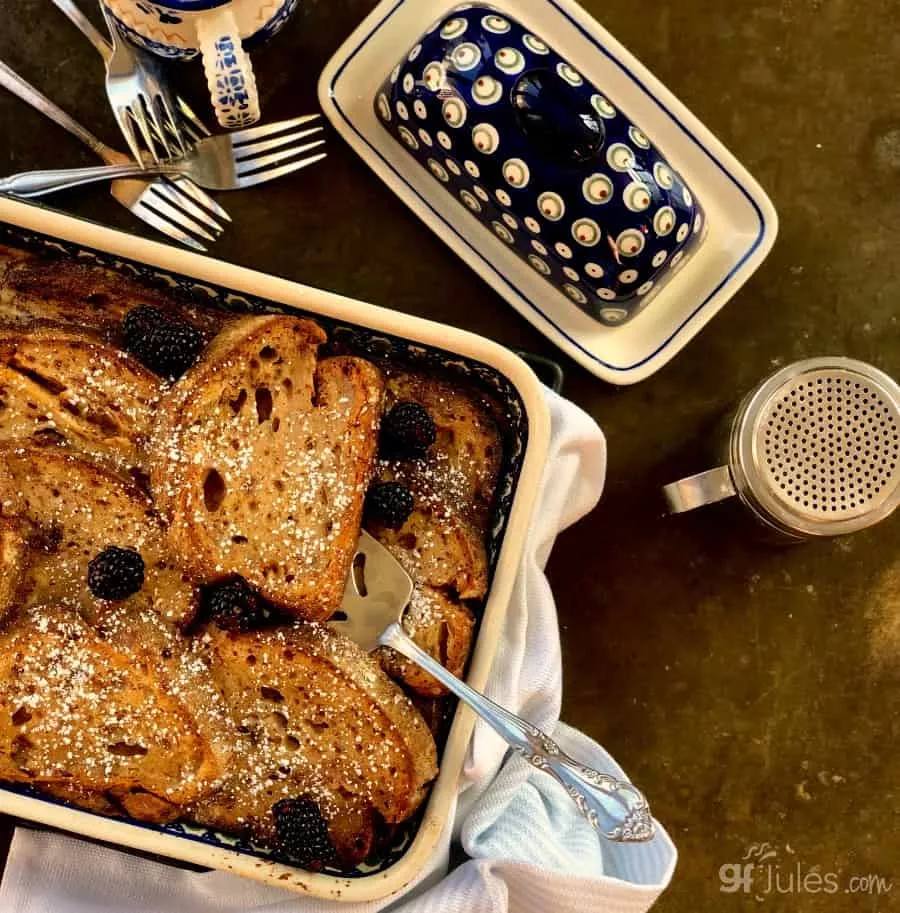
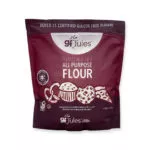
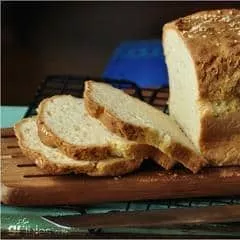
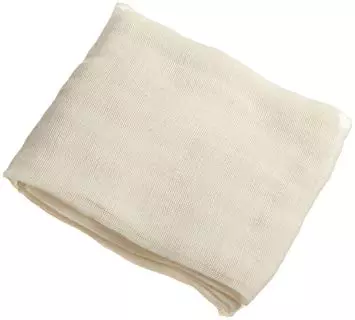



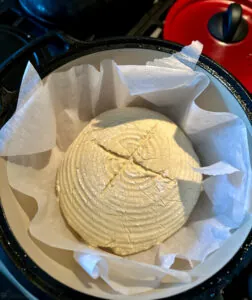

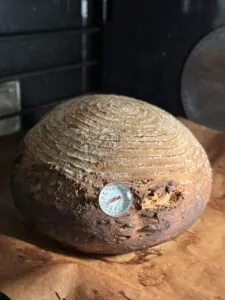
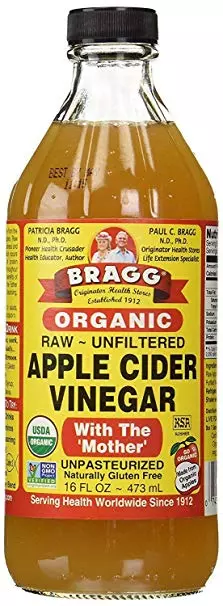
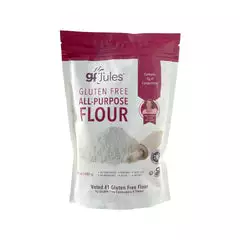











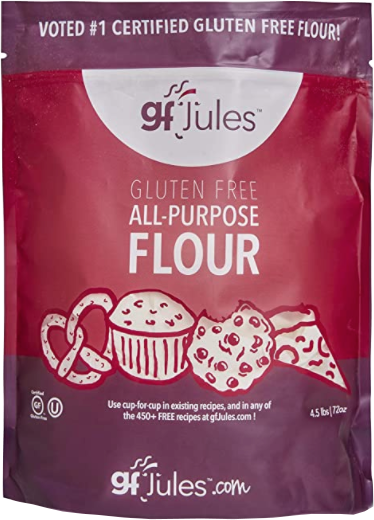
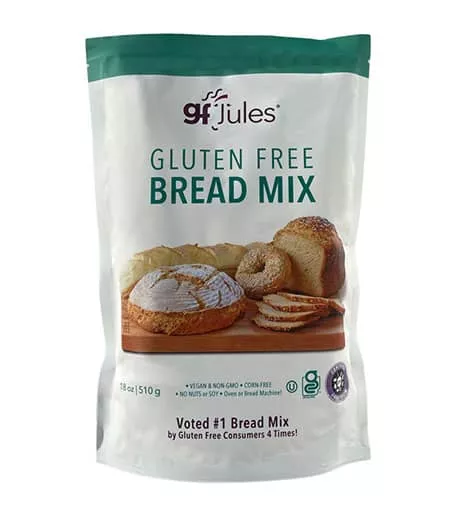

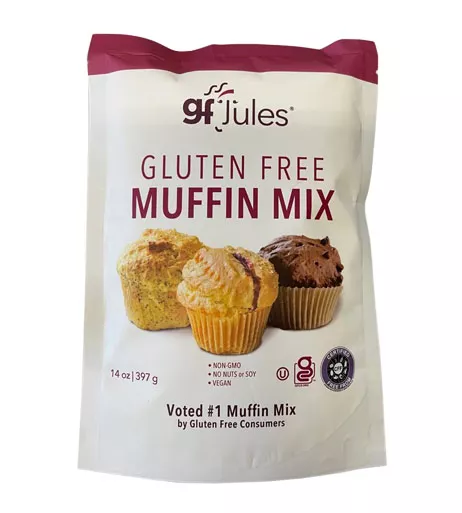


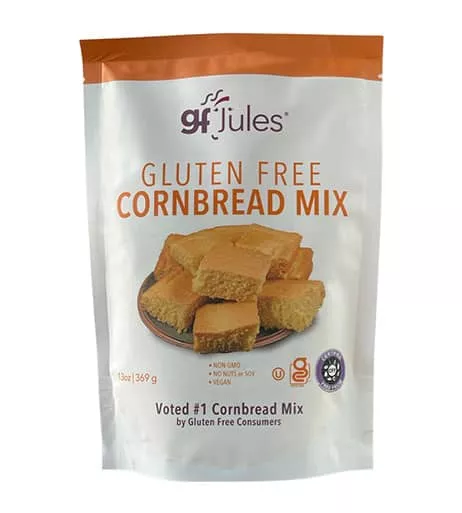



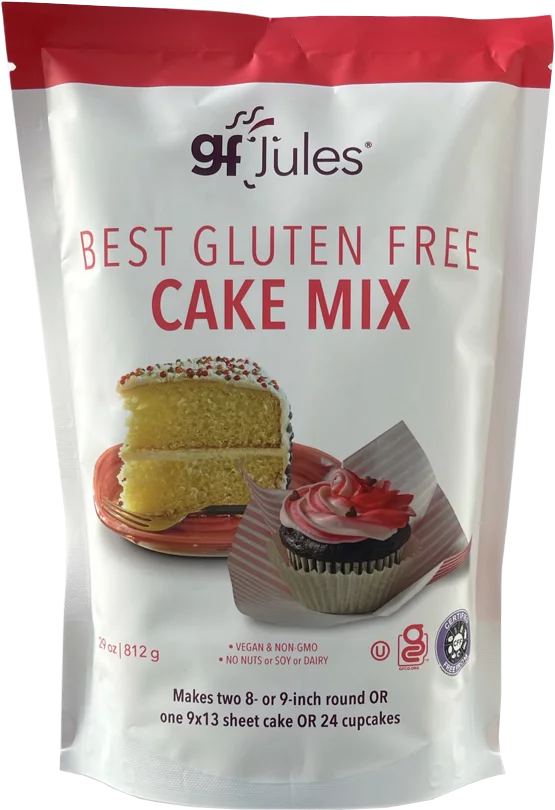
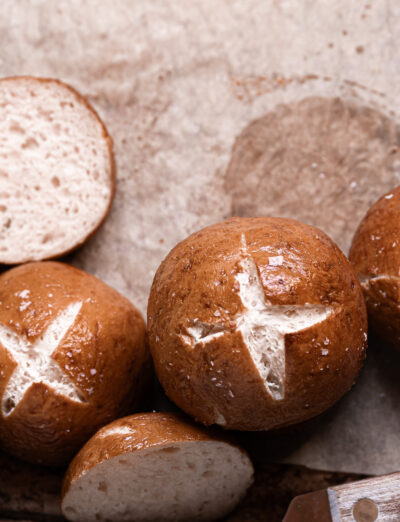

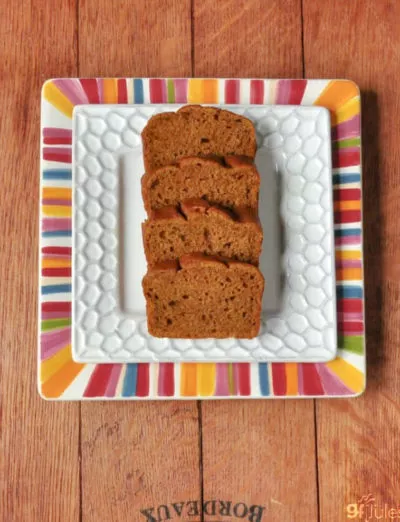








I’m in love with this recipe and your GF flour is everything. I have a very robust starter, and I’ve been experimenting a bit, substituting a few things, like the liquid used, and an alternative to psyllium husks. For the loaf below, I used 2 T of chia seeds, which also work well in place of xanthum gum (for anyone intolerant to gums). I generally use GF beer, but sometimes use…..Orangina !!! which I did for the loaf below. I also added a bit of turmeric powder and it came out beautifully. Thank you so much for developing this recipe. My husband is celiac, the rest of us avoid gluten, and I serve this bread to company as well. I bake it in a Lodge cast iron pan, with parchment paper.
Absolutely gorgeous gluten free sourdough, Kathy! I’m so happy this recipe has been working out so well for you and your family! Thanks so much for adding the substitutions you’ve made — so helpful!!!
~jules
Hi- I made my first loaf of GF bread using your GF flour and recipe and am amazed at the results! It really almost blew right out of the pan lol. Beautiful crust and crumb.
I baked bread as a hobby for many years until I was diagnosed with celiac- used to buy high-gluten flour for nice loaves and I was crushed when I found that I was making myself sicker and sicker with my hobby. But this loaf (my first in almost 20 years!) has me back on track again! The first of many to come, thanks to you!
Another shot of the crumb..
Stunning! The crumb looks perfect — and that crust! WOW!
~jules
Hi Mark, I’m thrilled that you are back in the bread baking biz! What a gorgeous loaf!!!! To go from high gluten flour baking to gluten free is quite the switch, but it seems you’ve gotten the hang of it. Thank you so much for sharing the photos of your loaf so I can share in your baking joy! I can’t wait to see what else you produce!
~jules
Finally got round to making your sourdough bread. It looks and smells amazing. Can’t wait for it to cool. I made it with buckwheat flour and my seltzer was flat (which I only found out while drinking the remainder at dinner). I made a little change, which was to preheat the Dutch oven to 500 degrees. I then baked with lid at 450 for 25 minutes and added 3 ice cubes before closing lid. I then finished for 40 minutes with no lid at 350. Internal temp was 215 after that. Thank you. I really appreciate the effort that went into creating this recipe.
GORGEOUS gluten free sourdough, Cristina! Thank you so much for sharing your photo and also your technique with the Dutch Oven! So glad the flat seltzer didn’t deter this beauty from rising in any way!
~jules
I would like to make an attempt at making my 1st sourdough starter but I am unable to digest xantham gum. Can I use gum free flour and add psyllium husks? How much would I need to add for this recipe?
Thank you
Hi Leta, check out this article on gluten free flours for more info on alternative gluten free flours and if you are adding psyllium in place of xanthan to make a blend.
~jules
Hi, Jules,
Do you have recommendations for adjusting your recipe for use at 7000 ft altitude? Thanks!
Hi Carol, yes! Check out my high altitude baking tips article for some ideas!
~jules
Hi! I’m making the starter right now and as well as being a bit slow, I am noticing a layer of water on top. I mix it well when I discard, and add in, and definitely not adding too much water, because the consistency is good, if anything maybe a little thick, but within a few hours that layer of water has developed again. Is this normal, or maybe slowing things down?
Hi Cate, you’re doing well!! That liquid is normal and means that your sourdough starter is doing its thing! It’s a little odd that it’s forming that fast, and might indicate that your ratios are off somewhat, but it’s nothing to worry about really. Just stir it back in and since you’re still working on getting it started, maybe back off the liquid you’re adding a bit and see if that helps.
~jules
I have made this sourdough recipe twice now. In both cases, even after 1 hour and 45 minutes of baking, the internal temperature never got above 190°. Both times I took it out, and it seemed to be fine. It wasn’t gummy in the middle, but the crust was starting to get a bit thick.
Is it normal for it to take that long and still not get up to temperature? I cooked it artisan style both times since I do not have a pullman pan.
Thank you!
In reading further, you talk about discarding each day. I have just been feeding my starter twice a day. Would that lead to a more dense loaf that is harder to get up to temperature?
Hi Rachel, yes you definitely need to be discarding with the feedings. I know it sounds like quite the process, but each step has its purpose!
~jules
I wouldn’t worry about the length of time it took to bake, as all ovens can bake differently. If you find that the crust is getting too thick though, you can try using a homemade Dutch oven by covering the loaf with an inverted large oven-safe pot, or you can cover the crust with foil after it has risen and started to form a crust.
~jules
Making your bread for the first time and I am curious about the plastic wrap. I double checked that it won’t melt even if the oven is 200* (when it is first put in) but I can smell the plastic a bit. Are there other options?
Hi Tessa, the oven should be turned OFF when you put the bread in to rise if you’re using that method, whether covering the bread with wrap or not! That rise method is just to warm the oven up a bit, and then you turn the oven off so it’s not actually cooking or drying out the bread and certainly not melting the plastic! 🙂
~jules
Jules, I love your site. Thanks for doing the work so we can have easy to follow recipes that are delicious. Any chance you will be branching out and developing more varied flour blends? I’m allergic to corn, so I can’t use your blend as often as I would like to.
Hi Judy, thanks so much for your sweet words! I do appreciate being appreciated! 🙂
My gfJules Bread Mix is corn free (not sure if you knew that!) and it can be used as a baking mix in lots of recipes. Just measure it out as a “flour” and don’t add any baking soda/powder or salt if a recipe calls for it, since it’s already in the bread mix.
I am also in the process of launching a new blend that it totally grain-free and nut-free as well, so stay tuned!!!! I’m always looking to hear from people about what they need, so please let me know!
Happy baking!
~jules
I’ve never seen a sourdough bread recipe that called for eggs, baking soda, baking powder and apple cider vinegar, not to mention the other ingredients. What is the reason for adding these? Just for your own flavor twist, or are they related to the bread being gluten free?
Hi Dane, the chemical leaveners do help the bread to get a bit more lift since it’s gluten free. The apple cider vinegar helps with the flavor, since it takes a bit of age before this starter really has much of a sour taste, but that can also depend on the gluten free flours used to make the starter. Eggs are for structure in the gluten free bread but the bread can be made vegan with substitutes if need be.
~jules
Thank you for taking the time to answer! I am very new to this. So you don’t cover your Pullman Pan unless it is over browning? I started the starter yesterday and it is looking great so far!
Hi Katie, I don’t cover my Pullman Pan, but that’s a matter of preference. It really depends on what kind of crust you’re looking for. I like a crustier loaf, so I leave mine uncovered, but since you have your starter going, you should try it both ways and see what you like! A Pullman pan is unique in that it can also control the shape of the top of the crust if you leave the lid on, as well.
~jules
Hi! Excited to make this, I’ve never made sourdough before but recently discovered my daughter and I need to be GF so we’re going to give this a try! A question about putting the dough in the pan – do you do any stretching/special shaping before putting it in? And do you bake it with the pan covered? Thanks!
Hi Katie, there’s no special stretching with this dough before-hand, as there’s no gluten in the dough to stretch. All the bread-making you’ve seen before about punching down and stretching is with doughs that had gluten in them and needed/could tolerate that kind of stretching. This dough will be more akin to a thick batter than that kind of dough. (Read more here!)
With regard to baking it covered, it all depends on the kind of pan you choose to use. You can use a Dutch oven or like the red baker pictured here and then it would be covered; otherwise, it would not be covered unless you find that the crust is overcooking and the inside is not yet done. At that point, I cover the crust with foil to finish the bake.
Enjoy the recipe!!!
~jules
@gfJules
I made your GF sour dough bread recipe. It’s rising as I write this. One question/discrepancy I ran into. The ingredients list calls for club soda or ginger ale but it is never asked for in the recipe. I’m confused as usual.
Hi Rich, sorry to confuse! Looks like you were able to push through and make the gluten free sourdough anyway! For next time, here’s the part of the recipe where the club soda/gingerale is added (I call it “bubbly liquid”):
“Slowly stir in dry ingredients or gfJules Gluten Free Bread Mix with bubbly liquid, beating with paddle attachment on a stand mixer or using a wooden spoon until the batter is smooth and all dry ingredients are completely integrated. Mix for two minutes with mixer, longer with spoon method.”
Hope that helps!
~jules
BTW, there’s no need to try to maintain a quart of starter. That requires a lot of feeding. Maintain a 1:1:1 ratio of fresh starter:flour:water in equal weights. like 10:10:10 for 30 grams of starter. A day before baking day, build the amount you will need the night before using 20g of your ripe starter and then adding flour and water as required by the recipe. Save back 10 grams to feed for maintaining. This process reduces discard and expense. There is only so much you can use – even when storing refrigerated. That’s why I dry mine then sub in for a portion of the flour used in the recipe. Also, being exact is not necessary. Some flours will result in a very thick starter so add a bit more water like a 1:1:1.5 ratio for more of a thick batter starter instead of a heavy paste.
Try this – this works for great gluten flour starters and discards very well. Dry your discard, pulverize it into a powder and add it into recipes for the flavor. You can also dry active, fully ripened starter as well. Just ensure both are completely dried before storing. I add a desiccate packet.
Here’s how: Spread either discard or starter onto a parchment or Silpat-lined baking sheet in a thin layer. For discard: Place in a low oven (like on warm or below 200 degrees F) until dry. Break up and place into a blender or food processor until powdered. Sift and repeat if too coarse. Add to recipes for flavor. For starter: Dry in an oven with the light on (or proof setting) until dried. You don’t have to powder it – just crush it – you’ll be rehydrating and rebuilding it later anyway. It kickstarts the fermentation process in just two days instead of a week or longer. Just rehydrate with an equal amount of water – let it sit for an hour. Feed two or three times with equal amounts of water and flour without discarding and fermentation activity should be evident. Maintain as usual.
Hi! Making the SD starter. First, after 24 hours, I already have an active starter – yay! Do I whisk in the flour and water, or just stir? Thanks!
Yay!!! Stirring in the flour and water should be fine unless it’s particularly lumpy. Have fun!!!
~jules
When do you add the carbonated beverage to the recipe for the gf sourdough bread?
Hi James, you’ll add the carbonated beverage together with the dry ingredients:
I hope that helps!
~jules
Wish I had seen this sooner. I made the recipe today and since it never called for the soda or ginger ale, I never added it. It’s in the oven rising. Can I still add the liquid at some point now? If I add it after letting it rise do I let it rise again?? BTW: I sent you an email from the spot below the recipe. You can ignore that if you’d rather answer me here. No worries either way. 1st time making the bread, can wait to try it. Tired of spending $6-$7 on loaves of bread. Plus I like the idea of making my own anyway. Thanks!!!!
Oh dear! I just saw this question AFTER seeing the other one! I was out of town with my daughter this weekend and am behind on responding to comments!!! It would be better to add the liquid at some point rather than not adding it at all … but in general, you want to mess with gluten free bread as little as possible after it has risen. Although since it had no liquid added, no doubt it was too dense to have risen, so you’d definitely want to have added the liquid to the dough anyway to give it any shot of turning out! So sorry for my delay in responding to your question. I feel your pain on the expensive loaves — making your own homemade will definitely be better when the liquids are added!!!!! 🙂
~jules
Can this be made in a dutch oven?
Hi Grace – yes it can! I believe there are others who have commented that they have made this gluten free sourdough recipe in a dutch oven, so check the comments, but it would be very similar to the Emile Henry baker that’s pictured here, in terms of results.
~jules
Hi! Here are some pix of my latest sourdough loaf (just sliced and ate a piece with butter, best thing ever!) I used the 1/4 c almond flour option, xanthan gum for the binder, Saco buttermilk powder (plus increased soda to a scant tsp, because buttermilk!), and the Bubly peach-pear carbonated water – all choices made because that’s what I had on hand. I let rise and then refrigerated overnight, took out about an hour before baking, and baked on convection setting an hour and 15 minutes (checked at 1 hour. Aren’t instant read thermometers wonderful?)
I’ve been feeding my starter since November, and it just keeps making better and better bread. This was the most delicious loaf yet, and I can’t wait to get home and have another slice!
And here’s the full loaf before slicing!
Okay I’ve had horrible luck with previous sourdough recipes but THIS one…it turned out beautifully. I let it rise on the counter and then put it in the refrigerator overnight and baked it this morning before work. It isn’t particularly sour, but the flavor is absolutely outstanding and the crust is crisp without being tough (I put a cup of ice cubes in a pan below the bread.) Would share a pic but it’s too big. 100% recommend!
CONGRATULATIONS Rebecca! I’m so happy you didn’t give up after having previous attempts not turn out so well! If you want to send a photo to support@gfJules.com we’ll be glad to shrink the photo and upload it for you … or just to show us. I’m dying to see it!!!!!
~jules